Blue Wall Voices Project
Key Findings
Blue Wall Voices Project
A Collaboration Between KFF and The Cook POlitical Report
The Kaiser Family Foundation and Cook Political Report have embarked on a new project examining the attitudes and experiences of voters in several key battleground states leading up the 2020 presidential election. The Blue Wall Voices Project is a unique state-based polling project that relies on an innovative probability-based approach to conducting public opinion polls using a combination of telephone and online methodologies. Drawing from voter registration lists, KFF and Cook Political Report have conducted interviews with 3,222 voters in the four states constituting the “Democratic Blue Wall” – the area in the Upper Midwest that was previously considered a Democratic stronghold, and where state polls performed poorly in 2016 and underestimated support for President Trump. The data analyzed is from 767 voters in Michigan, 958 voters in Minnesota, 752 voters in Pennsylvania, and 745 voters in Wisconsin. For more details, please see the methodology section of this report.
- There are many undecided voters and a few persuadable swing voters. One year out from the 2020 presidential election and without a clear frontrunner in the Democratic primaries, a large share of voters – about four in ten (41%) – say they have not yet made up their minds about who they plan to vote for in November 2020. These “swing voters” either report being undecided about their vote in 2020 or are leaning towards a candidate but haven’t made up their minds yet. With a substantial number of votes still up for grabs, this analysis looks in-depth at this group of voters to explore the policy issues that could swing these voters to vote for either President Trump or the Democratic nominee.
- President Trump himself is the defining factor for voters – both positive and negative. When asked to offer in their own words what one thing will motivate them to vote in the 2020 presidential election, nearly three times as many voters offer responses related to defeating President Trump (21%) as offer responses related to re-electing him or not wanting a Democrat to be elected (8%). Defeating President Trump was offered as the top motivation to vote in 2020 by four in ten Democratic voters (39%) while responses related to re-electing President Trump/not wanting a Democrat were offered by 21% of Republican voters. One-fifth of independent voters offered responses related to defeating President Trump while fewer (7%) of independent voters offered responses related to re-electing President Trump. Overall, one-fourth (23%) of voters offer issues such as health care, the economy, and immigration, as their motivation for voting in the 2020 presidential election.
- The 2020 election may be a lot about health care and the economy, two issues that voters judge President Trump’s actions on very differently. Health care and the economy are the top issues for voters leading up to the 2020 presidential election but they are also two issues on which voters give President Trump very different marks. Overall, voters are somewhat positive in their views of how President Trump is handling the economy (-1 percentage points net approval) while a larger share of voters “disapprove” than “approve” of the way President Trump is handling health care (-21 percentage points net approval). Health care is one of the only issues in which President Trump’s approval is lower than his overall job approval (-18 percentage points). President Trump also has low approval ratings (-20 percentage points) on the way he is handling foreign policy– an issue of increasing importance among voters in these states.
- Democrats have a slight edge in enthusiasm in three of the four states heading into the 2020 presidential election. Over six in ten Democratic voters in Pennsylvania (66%), Michigan (65%), and Wisconsin (62%) say they are more motivated to vote in next year’s 2020 presidential election than they were in 2016. This is at least 10 percentage points higher than the share of Republican voters in each state saying the same (54% in Pennsylvania, 53% in Michigan, and 46% in Wisconsin). Republican voters in Minnesota are as motivated as their Democratic counterparts. To see more on Republican voters in Minnesota, check out the Minnesota-specific report.
- President Trump still has solid support among his base in this region. Most Republican voters approve of the way Donald Trump is handling his job as president and large majorities approve of his approach on key national issues including more than nine in ten who approve of the way he is handling the nation’s economy. Most Republican and Republican-leaning voters (73%) also say they want President Trump to be the Republican Party’s nominee for the 2020 election while small shares of Trump voters (28%) can imagine a scenario in which he enacts a policy, or fails to enact a policy, that would result in them changing their vote choice.
- Few Democratic voters see progressive positions as deal breakers in their 2020 vote. The Blue Wall Voices Project also sought to find out whether the progressive positions being discussed by the Democratic nominees for president on the campaign trail are deal breaker issues for voters. Overall, a majority of voters in the Blue Wall who plan to vote for the Democratic nominee view the progressive platforms asked about in this survey as “good ideas,” including majorities of voters in each of the four states. None of these issues are deal breakers, with most voters saying that if a candidate disagrees with them on this issue then there would still be a chance that they would vote for them.
- Most swing voters in these states see bans on fracking, stopping detainments at the U.S. border, and Medicare-for-all as bad ideas. The poll also consistently finds that while Medicare-for-all has played a significant role in the 2020 Democratic primary debates, it is not the top health care issue for Democratic voters. Large shares of swing voters in Michigan, Minnesota, Pennsylvania, and Wisconsin say stopping detainments at the U.S. border for people cross into the country illegally and a national Medicare-for-all plan are “bad ideas.” Swing voters are slightly more divided in their views of a ban on fracking with large shares of Pennsylvania and Wisconsin swing voters saying such a ban is a “bad idea” as do a slim majority in Michigan and half of Minnesota swing voters.
- As the Democratic presidential primary heats up, this poll finds Senator Elizabeth Warren and Vice President Joe Biden as the front-runners among Democratic primary voters in the Blue Wall region. One-fourth of Democratic primary voters in Michigan and Minnesota say they plan to support Sen. Warren during the Democratic primary as do 22% of Wisconsin Democratic primary voters. Former Vice President Joe Biden garners 27% of support from Pennsylvania Democratic primary voters. Minnesota Senator Amy Klobuchar also garners support from 15% of Minnesota Democratic primary voters.
The Role Of Swing Voters In The Blue Wall
More than half of voters in Michigan, Minnesota, Pennsylvania, and Wisconsin say they have already made up their minds about which candidate they plan to vote for. One-third of voters say they are “definitely going to vote for the Democratic nominee” while one-fifth (22%) say they are “definitely going to vote for President Trump.” The share who say they are “definitely going to vote for President Trump” in these states is slightly lower than the share of voters nationally who reported the same in our national KFF Health Tracking Poll analysis earlier this year. It is important to note that while there are currently a larger share of voters in each state who say they are “definitely going to vote for the Democratic nominee” than “definitely going to vote for President Trump,” it is unclear how this could change once the Democrats choose a nominee and President Trump and other Republicans start attacking a single candidate rather than the entire field of candidates.
This leaves four in ten voters (41%) as the crucial voting block known throughout this report as “swing voters.” This group of voters either say they are “probably going to vote for President Trump” (11%), “probably going to vote for the Democratic nominee” (8%), or say they are “undecided” about how they will vote (23%).

There are not significant differences across the states, with similar shares of voters in Michigan (43%), Minnesota (41%), Pennsylvania (39%), and Wisconsin (43%) saying they are either “probably” going to vote for a candidate or are “undecided.”
It is important to note that not all “swing voters” could potentially change their vote to support the other party’s candidate. While nearly half of those who say they are probably going to vote for President Trump say there is “a chance” they will vote for the Democratic nominee (4% of all voters), on the other side of the ballot almost none of those who say they are probably going to vote for the Democratic nominee say that there is “a chance” they will vote for President Trump (less than 1%).

This is similar to what we found in our national analysis earlier this year, with few voters who say they are probably going to vote for either President Trump or the Democratic nominee saying there is “a chance” they will vote for the other party’s candidate. This is also similar across the four states included in this analysis with few voters saying there is “a chance” they would vote for the other party’s candidate.
A majority of Democratic voters and Republican voters in each state say they aren’t going to cast a vote for the other party’s candidate. About seven in ten (72%) Democratic and Democratic-leaning independent voters in Michigan say they are definitely going to vote for the Democratic nominee as do two-thirds of Democratic voters in Minnesota (68%), Wisconsin (66%), and Pennsylvania (65%).

A smaller share, but still a majority, of Republican and Republican-leaning independent voters say they are definitely going to vote for President Trump (58% in Minnesota, 53% in Wisconsin and Pennsylvania, and 52% in Michigan). Nearly twice as many Republican and Republican-leaning voters in Michigan and Wisconsin are undecided about their 2020 presidential vote choice as the Democratic counterparts in the states.1
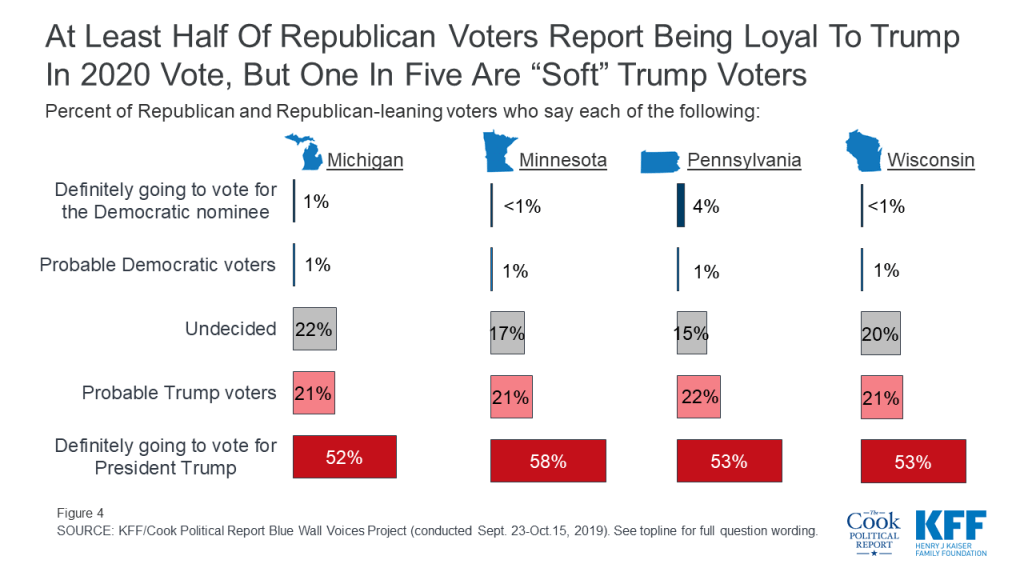
On most demographics, swing voters look very similar to their counterparts (voters who say they have already decided who they are going to vote for in the 2020 election), but they differ on three key variables: age, party identification, and ideology. Swing voters generally are more likely to say they are moderate in terms of their ideology (58%) and a larger share identify as political independents (29%) than their decided counterparts (5%). In addition, swing voters are slightly younger as a whole with about half (51%) under the age of 50 compared to 42% of decided voters.
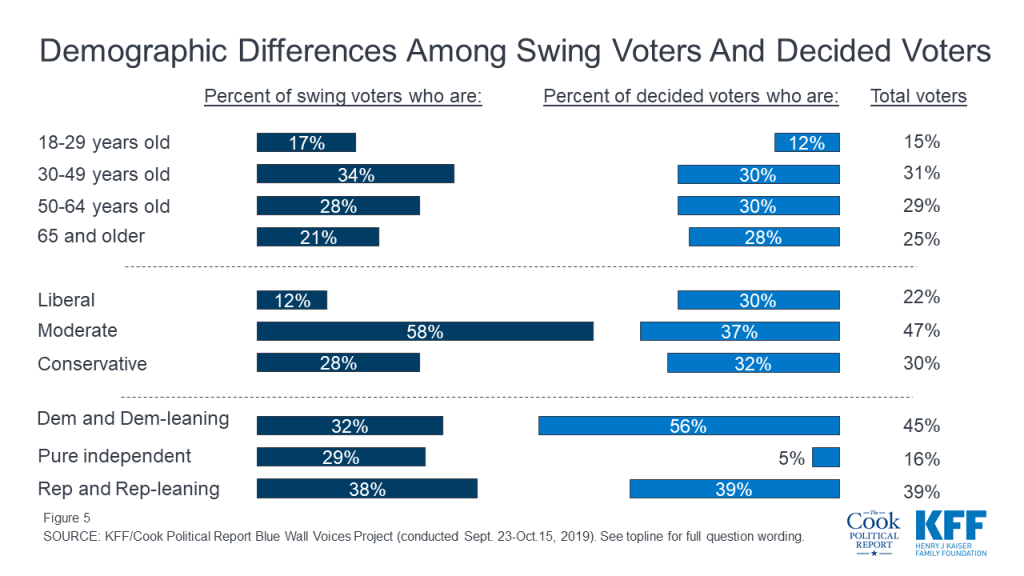
What Is Driving Voters?
During the 2016 election, President Trump ran as an unconventional candidate who was going to work to implement bold changes in this country and deliver a shock to business as usual in Washington, D.C. One year out from the 2020 election, a slightly larger share of voters – including a majority of Republican voters – still prefer to vote for a candidate who wants to make bold changes rather than moderate changes. A slightly larger share of voters in Michigan, Minnesota, Pennsylvania, and Wisconsin say they prefer to vote for a candidate in 2020 who wants to make bold changes (54%) rather than a candidate who works to make moderate changes (45%).
Six in ten Republican voters (62%) say they prefer a candidate who works to make bold changes rather than a candidate who works to make moderate changes (37%). Democratic voters are more divided on their preference with half (52%) preferring a candidate who works to make bold changes and a similar share preferring a candidate who works to make moderate changes (48%). A majority of independent voters (55%) prefer a candidate who works to make moderate changes.

Democratic voters appear to have the edge in motivation one year out from the 2020 general election with a larger share of Democratic voters (64%) saying they are “more motivated” about voting in next year’s presidential election than either independent voters (55%) and Republican voters (53%).

About two-thirds of Democratic voters in Pennsylvania (66%) and Michigan (65%) and six in ten Democratic voters in Wisconsin (62%) say they are “more motivated” to vote in next year’s election. This is compared to less than half of Republican voters in Wisconsin (46%) and slightly more than half of Republican voters in Pennsylvania (54%) Michigan (53%) who say they are more motivated to vote than in the previous presidential election. Partisan voters in Minnesota are both “more motivated” to vote in next year’s election. To see more on this, check out the individual state reports.
| Table 1: The Democratic Party has the Enthusiasm Edge in Michigan, Pennsylvania, and Wisconsin | ||||
| Percent who say they are more motivated to vote in next year’s election than in the 2016 election: | Michigan | Minnesota | Pennsylvania | Wisconsin |
| Total | 55% | 52% | 58% | 51% |
| Democratic voters | 65 | 57 | 66 | 62 |
| Independent voters | 61 | 47 | 54 | 50 |
| Republican voters | 53 | 59 | 54 | 46 |
When asked to offer in their own words what one thing will motivate them to vote in the 2020 presidential election, one-fifth of all Blue Wall voters offer responses related to defeating President Trump (21%). This is followed by those who say voting is their civic duty (9%), health care (8%), re-electing President Trump or not wanting to elect a Democrat (8%), and the economy (4%) is their top motivation. Overall, one-fourth (23%) of voters offer issues such as health care, the economy, and immigration, as their motivation for voting in the 2020 presidential election.
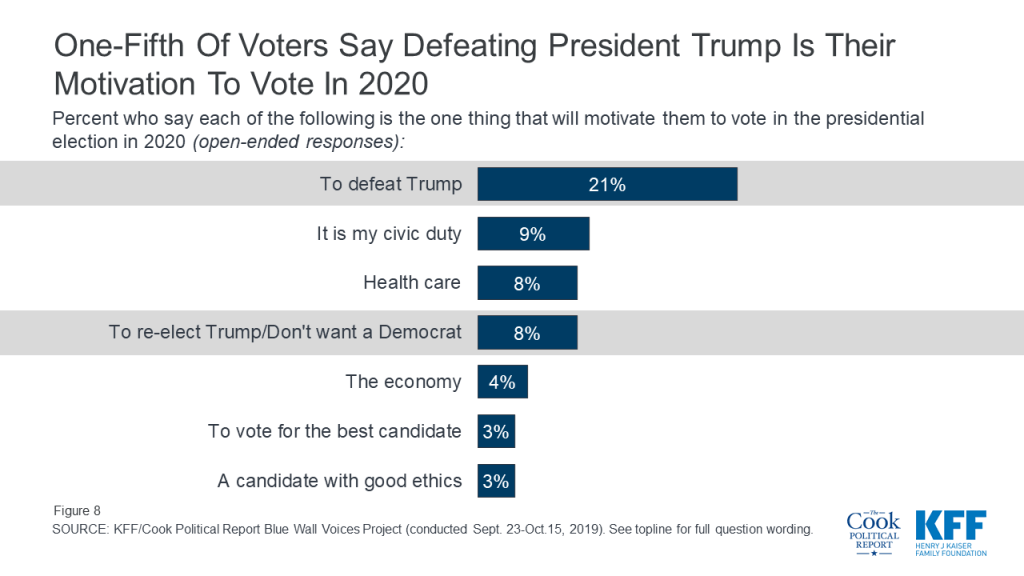
Defeating President Trump is offered as the top motivation to vote in 2020 by four in ten Democratic voters (39%) and one-fifth of independent voters, while responses related to re-electing President Trump or not wanting to elect a Democrat was offered by 21% of Republican voters – followed by those who say that their civic duty is their top motivation to vote in 2020 (12%).
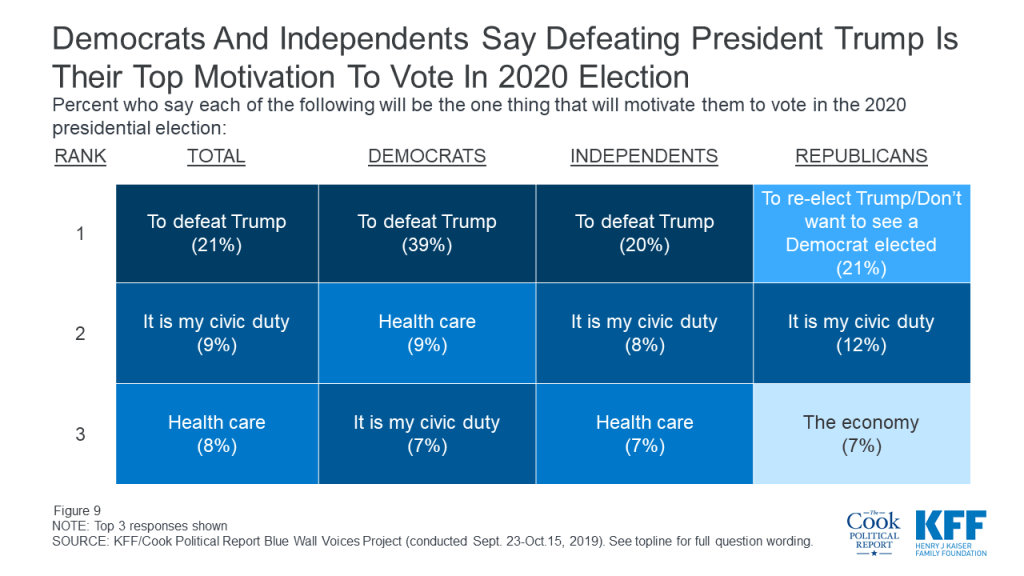
Republican Voters And President Trump
Most Republican and Republican-leaning independent voters (73%) also say they prefer President Trump to be the Republican Party’s nominee for the 2020 election with about one-fourth (26%) saying they prefer another candidate to be the Republican Party’s nominee. Those who self-identify as Republicans are more tied to President Trump with nearly eight in ten (78%) saying they prefer President Trump be the nominee compared to about six in ten (62%) independents who lean Republican in their views.
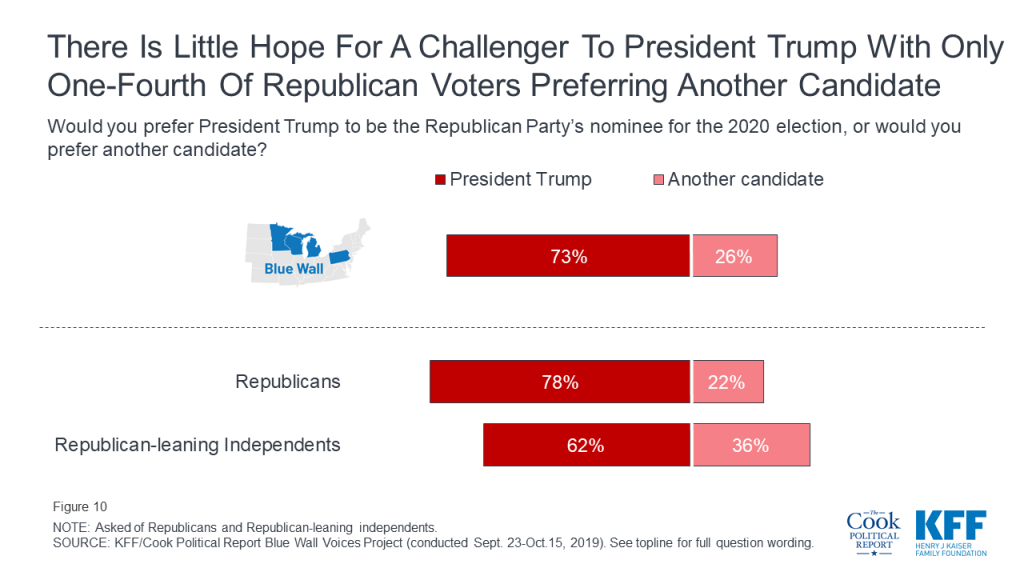
Most voters who say they are going to vote for President Trump in 2020 do not see a scenario in which he would no longer have their vote. Seven in ten Trump voters say there is not a policy he could enact or fail to enact that would make them no longer vote for him while three in ten (28%) say they can think of a scenario that would make them no longer vote for President Trump.
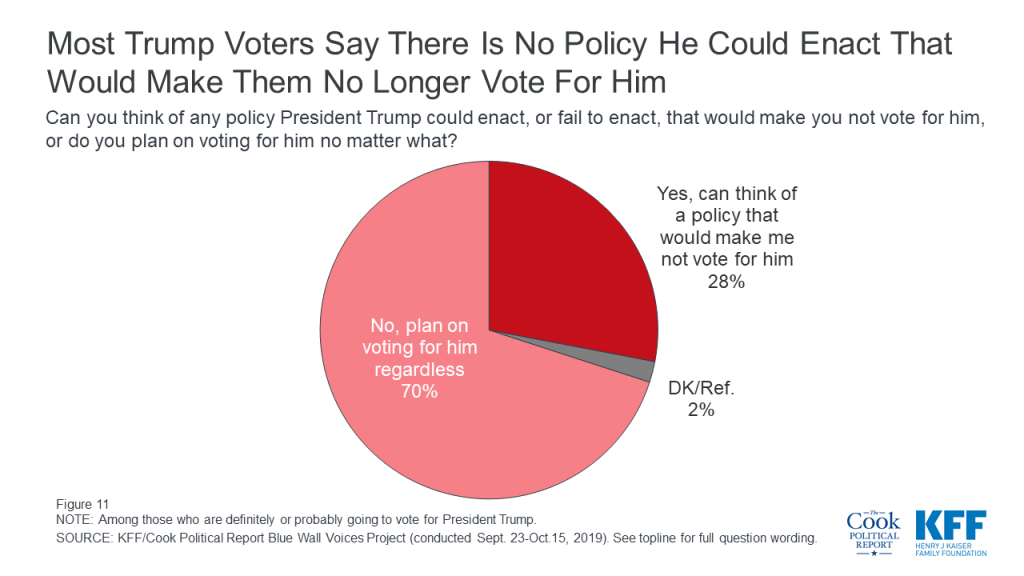
When asked to offer in their own words what policy President Trump could enact, or fail to enact, that would make them no longer vote for him, one-fifth (6% of all 2020 Trump voters) say that if he no longer continued to support gun rights they would no longer vote for him. This is followed by one in six (4% of all 2020 Trump voters) who offered that if he changed his position on immigration, they would no longer vote for him. Other issues that were offered include supporting Medicare-for-all (2%), supporting access to abortions (2%), or if foreign relations worsened (2%). Few Trump voters said they would not vote for President Trump if he endangered the constitution (1%).2
Democratic Voters And The 2020 Democratic Primary
Democratic voters in the Blue Wall are divided in what is most important to them when selecting a candidate for president. Four in ten voters (42%) say it is more important that the Democrats select a candidate who “has the best chance to defeat President Trump” while a similar share (40%) say it is more important to select a candidate who “comes closest to their views on the issues.” Fewer (13%) voters say it is more important to select a candidate who “is the most authentic” and even fewer (4%) say it is most important to select a candidate who “can most disrupt the current system.”

A larger share of Democratic and Democratic-leaning independent voters in Minnesota say it is more important that the eventual nominee be able to defeat President Trump (48%) than come closest to their views on the issues (33%).
| Table 2: Minnesota Democratic Voters Prioritize Defeating President Trump | |||||
| In selecting a presidential nominee for the Democratic Party, which of the following is most important to you? | Total | Michigan | Minnesota | Pennsylvania | Wisconsin |
| Has the best chance to defeat President Trump | 42% | 42% | 48% | 40% | 39% |
| Comes closest to your views on the issues | 40 | 45 | 33 | 38 | 42 |
| Is the most authentic | 13 | 11 | 16 | 13 | 17 |
| Can most disrupt the current system | 4 | 2 | 3 | 7 | 2 |
| NOTE: Among Democratic and Democratic-leaning independents. | |||||
Yet, despite this, significant shares of Democratic voters in each of the states say they do not plan to vote in the Democratic primary in their state and instead plan to wait to vote until the 2020 general election. One-third of Democratic and Democratic-leaning voters in Minnesota say they plan to wait to vote until the 2020 general election as do one-fourth of Democratic voters in Michigan, one-fifth of Democratic voters in Wisconsin, and 17% of Democratic voters in Pennsylvania.
Senator Warren and Vice President Biden Top List Of Democratic Primary Candidates
Among those primary election voters, Senator Elizabeth Warren and former Vice President Joe Biden have the edge over the other major Democratic presidential candidates. One-fifth of Democratic primary voters say Sen. Warren (22%) is the candidate they plan to support which is similar to the share who say Vice President Biden is the candidate they plan to support (21%). While Senator Warren and Vice President Biden garner similar shares of top choice votes among Democratic primary voters across the Blue Wall, four in ten Democratic primary voters choose Sen. Warren as either their first or second choice in the Democratic primary. This is followed by 29% who choose Vice President Biden, one-fourth who choose Sen. Sanders, and 14% who choose Mayor Pete Buttigieg. Most of the shift over to Sen. Warren is from Sen. Sanders supporters with half of Sen. Sanders supporters choosing Sen. Warren as their second choice of candidates. For more information about how voters in each of the states rank the candidates, check out the individual state reports.
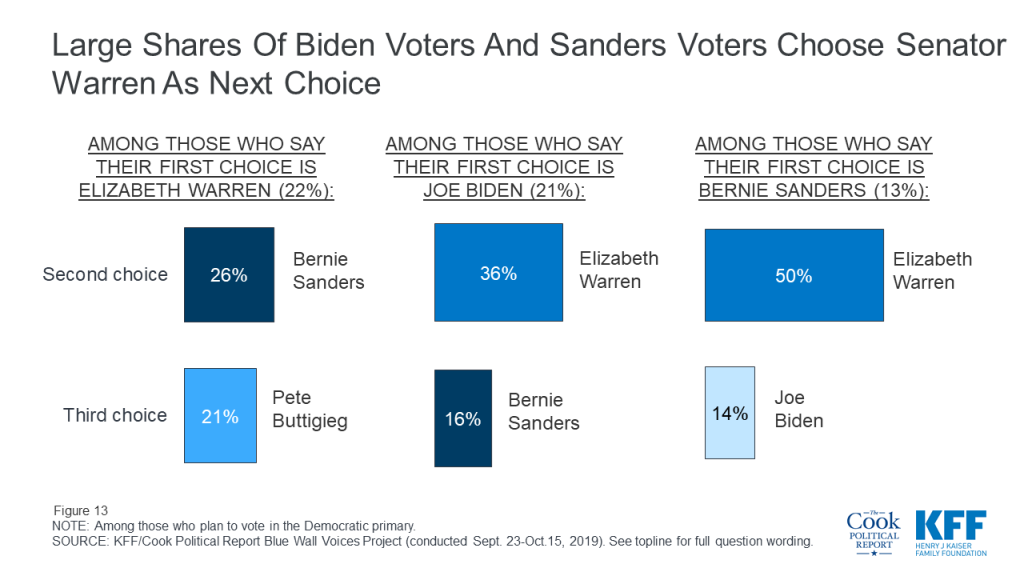
The 2020 Democratic candidates are garnering support from slightly different voting groups throughout Michigan, Minnesota, Pennsylvania, and Wisconsin. Across the four states, a larger share of voters who chose Senator Sanders as their first choice are men (50%) compared to those who chose Senator Warren (35%) or Vice President Biden (43%) as their first choice candidate. Sen. Sanders also has an edge among younger voters with eight in ten of his supporters under the age of 50. Sen. Warren’s supporters, on the other hand, are more likely to be women (65%), and have at least a college degree (65%) compared to less than half of Sen. Sanders’ supporters or Vice President Biden’s supporters. About one in five of Vice President Biden’s supporters are African-American compared to smaller shares of Sanders’ supporters (9%) or Warren’s (7%).
Are Progressive Platforms Deal Breakers For Voters?
The Blue Wall Voices Project also seeks to find out how voters view many of the progressive positions being discussed by some of the Democratic nominees for president. Overall, a majority of voters in the Blue Wall who say they are either “definitely” or “probably” going to vote for the Democratic nominee view the progressive platforms asked about in this survey as “good ideas.” This includes majorities of these self-reported likely 2020 Democratic voters in each of the four states.
Nine in ten self-reported 2020 Democratic voters (92%) say the Green New Deal, the plan to address climate change through new regulations and increases in government spending on green jobs and energy-efficient infrastructure is a “good idea.” This is closely followed by large majorities who say a pathway to citizenship for immigrants in the U.S. illegally (91%), a ban on the future sale of assault weapons (88%), and a ban on the ownership of assault weapons and military-style rifles like the AR-15 including a mandatory buyback program for current owners (83%) are “good ideas.” Fewer, but still a majority (62%), say a national health plan in which all Americans would get their health coverage through a single government plan, Medicare-for-all, is a “good idea.” Slightly more than half of self-reported 2020 Democratic voters say stopping U.S. detainments for people crossing the border illegally or a ban on fracking are “good ideas” (56% and 54%, respectively). These three issues rank at the bottom of progressive platforms for self-reported 2020 Democratic voters in each of the four states.
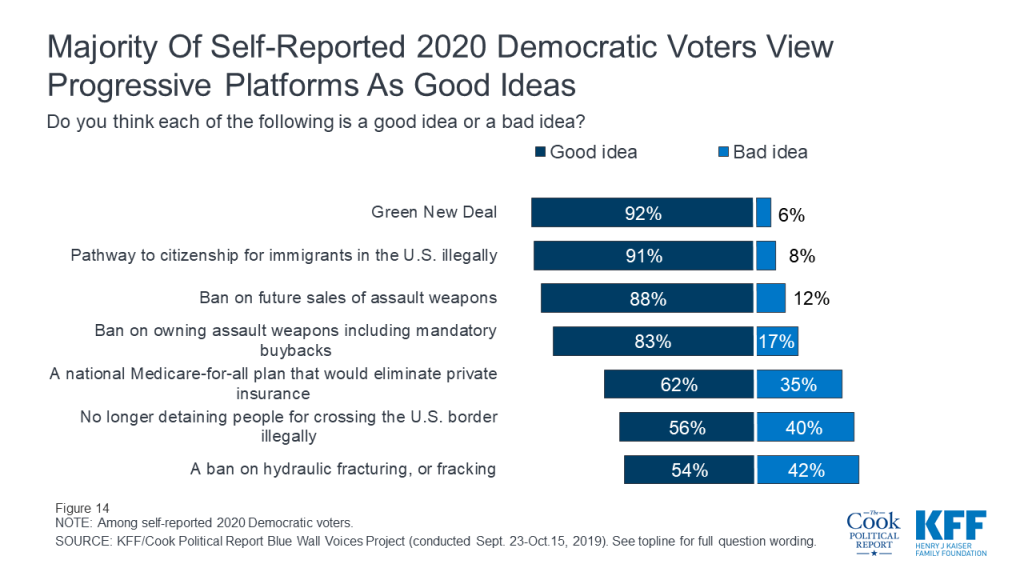
Yet, none of these issues are “deal breakers” with small shares of voters saying there is no chance they would vote for a candidate who disagreed with them on the issue. The positions that solicit that largest share of voters saying there is “no chance” they would vote for them are if a candidate was against a ban on future sales of assault weapons (20%), against a ban on ownership of assault weapons (15%), or against the Green New Deal (13%).
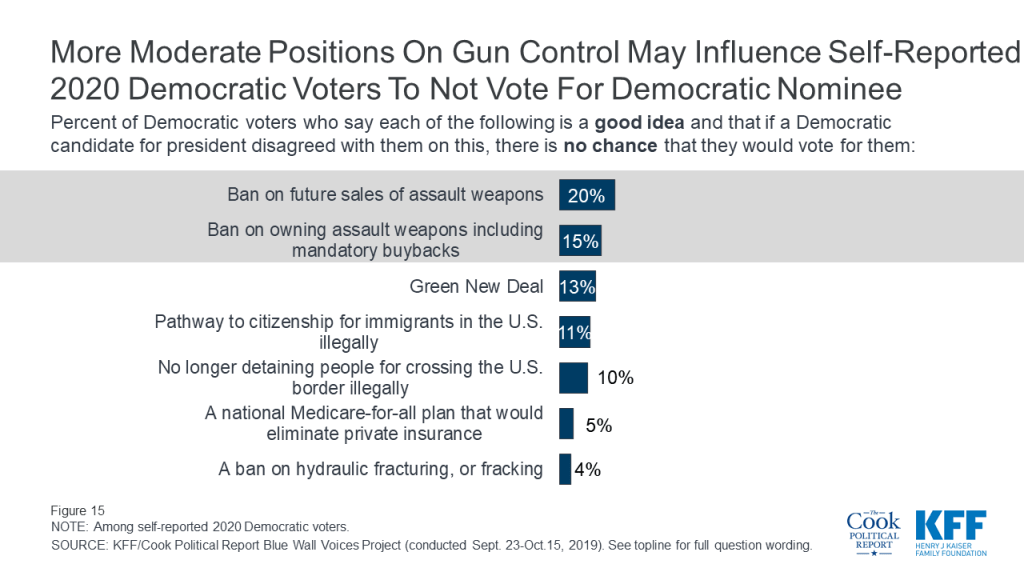
Few self-reported 2020 Democratic voters view any of the progressive ideas as deal breakers with less than 10% of Democratic voters saying the platforms are “bad ideas” and if a Democratic candidate disagreed with them on this, there is no chance they would vote for them.
Some 2020 Democratic voters see Conservative gun Control Stance As A Possible Deal breaker
Many likely 2020 Democratic voters see more moderate positions on assault weapon bans as possible deal breakers. One-fifth of self-reported 2020 Democratic voters say there is “no chance” they would vote for a candidate who was against a ban on the future sales of assault weapons and about one in eight (15%) 2020 Democratic voters say there is “no chance” they would vote for a Democratic nominee who was against a ban on owning assault weapons, including a mandatory buyback program.
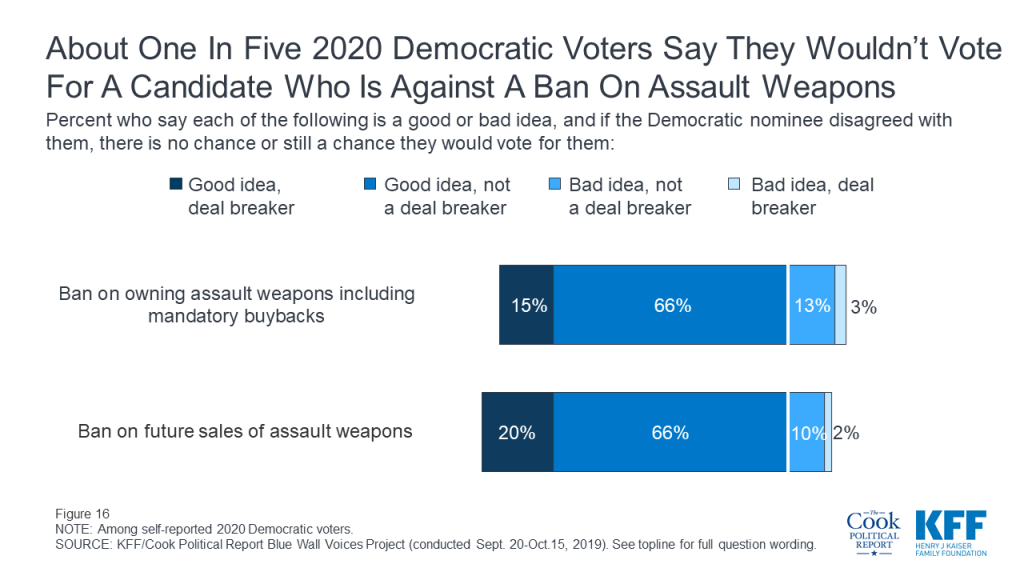
Swing Voters And Progressive Platforms
Majorities of swing voters, a crucial voting block in 2020, view a pathway to citizenship for immigrants in this country illegally (70%), the Green New Deal (67%), a ban on the future sale of assault weapons (66%), and a ban on the ownership of assault weapons including a mandatory buyback program (54%) as good ideas. Yet, many of these voters see three progressive platforms as “bad ideas.” Majorities of these voters view a ban on fracking (54%), a national Medicare-for-all plan (62%), and stopping border detainments of people coming into the country illegally (71%) as bad ideas.
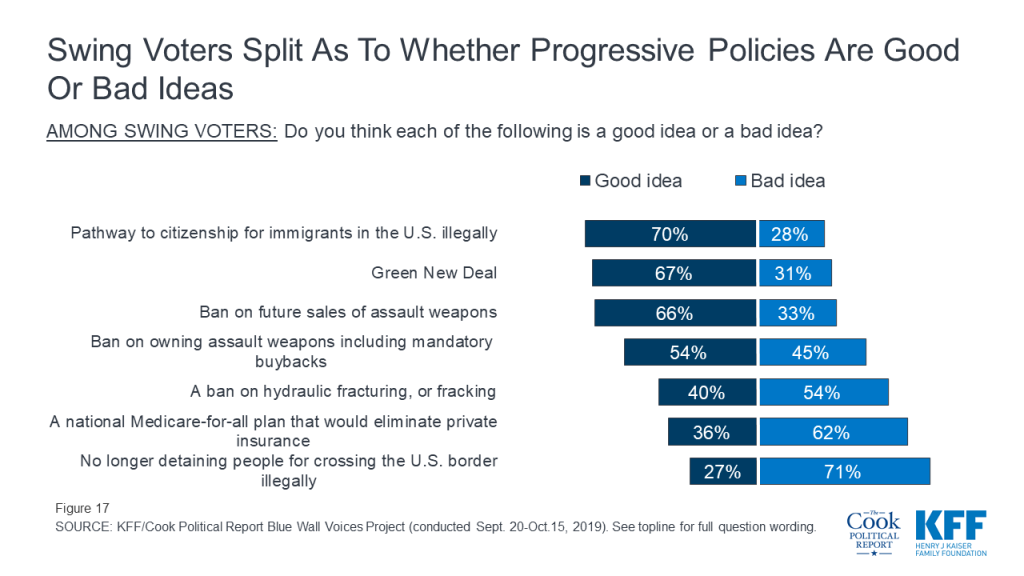
How National Issues May Influence 2020
Health care and the economy are the top issues for voters in these states leading up to the 2020 presidential election but they are also two issues on which voters give President Trump very different marks. Voters give President Trump a somewhat positive rating (-1 percentage points) on the way he is handling the economy while a larger share of voters disapprove than approve of the way President Trump is handling health care (-21 percentage points net approval). Health care is one of the only issues in which President Trump’s approval is lower than his overall job approval (-18 percentage points). This report also examines the role of other key issues in the 2020 election such as immigration and international trade.
President Trump Job Approval
President Trump’s approval in each of the states as well as the Blue Wall overall is similar to what we see in national polls with about four in ten voters (41%) in the Blue Wall saying they either “strongly approve” or “somewhat approve” of the way Donald Trump is handling his job as president, while six in ten (59%) disapprove. If we look at the strongest opinions, twice as many voters “strongly disapprove” of the job President Trump is doing than “strongly approve” (50% v. 25%). About half of voters in each of the four states strongly disapprove of the way Donald Trump is handling his job as president.
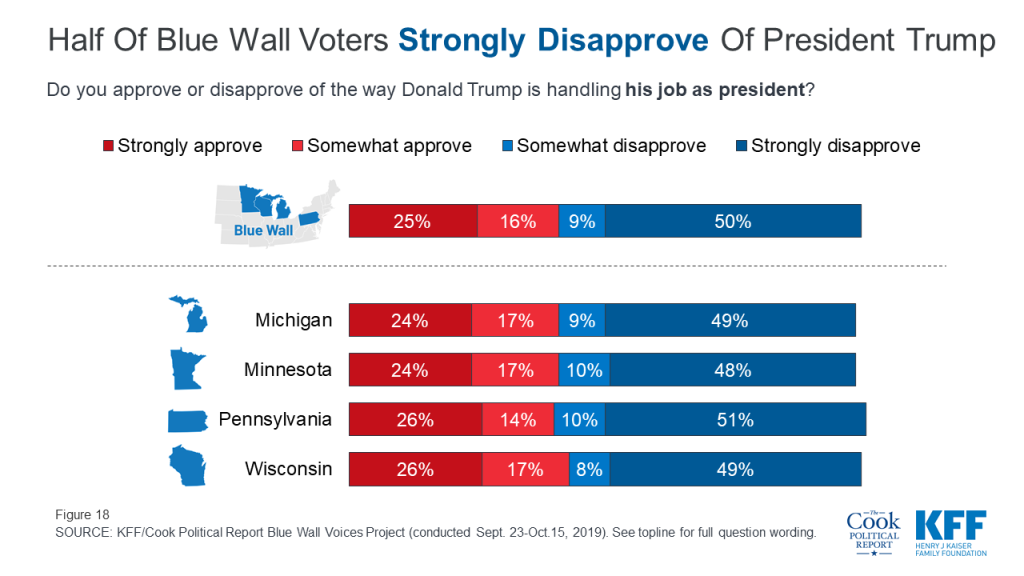
Support for President Trump runs highest among his base including voters who voted for him in 2016 (89%), conservative voters (78%), and rural voters (57%).
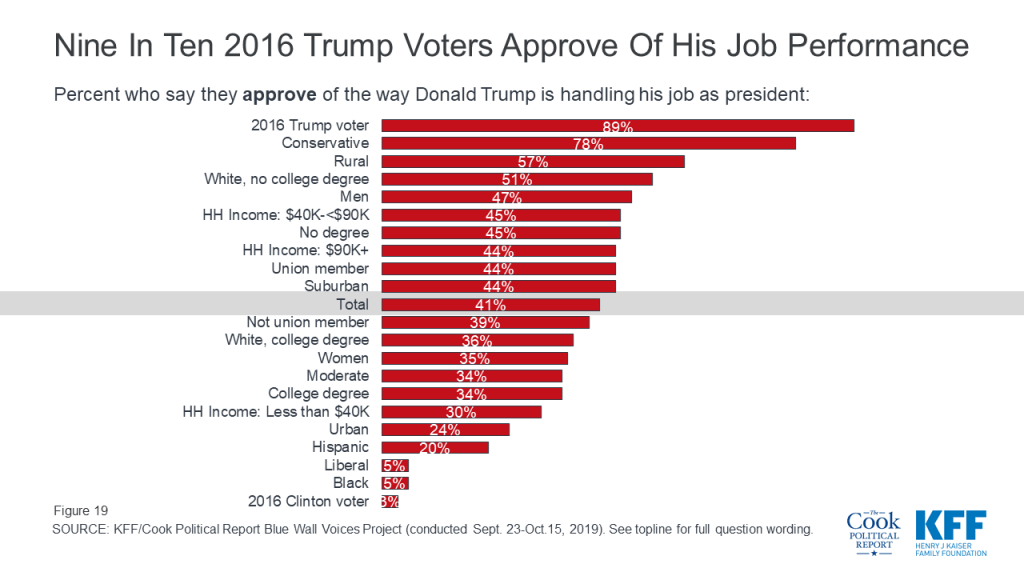
On the other hand, vast majorities of 2016 Clinton voters (97%) and liberal voters (95%) disapprove of his job performance. As do non-white voters across education groups, urban voters, voters earning less than $40,000 annually, moderate voters, and many more.
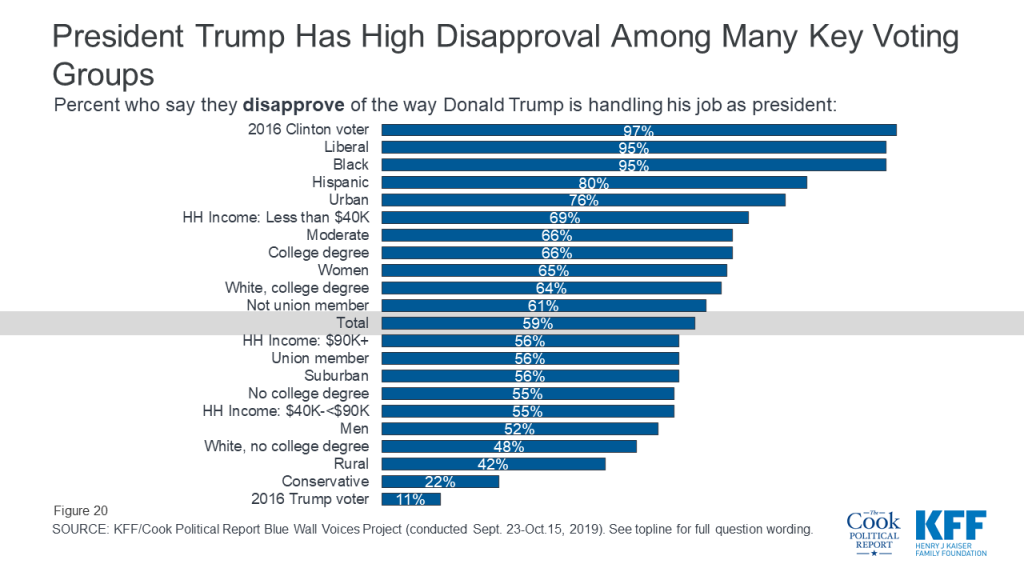
Voters in the Blue Wall states rank President Trump’s job performance most positively on the economy with about half of voters (49%) approving of the way Donald Trump is handling the economy. About four in ten voters approve of the job he is doing on the other issues including trade with other countries (43%), immigration (43%), foreign policy (40%), and health care (39%). There are no differences across the four states with similar shares of voters in Michigan, Minnesota, Pennsylvania, and Wisconsin approving of President Trump’s job on each of these key issues.
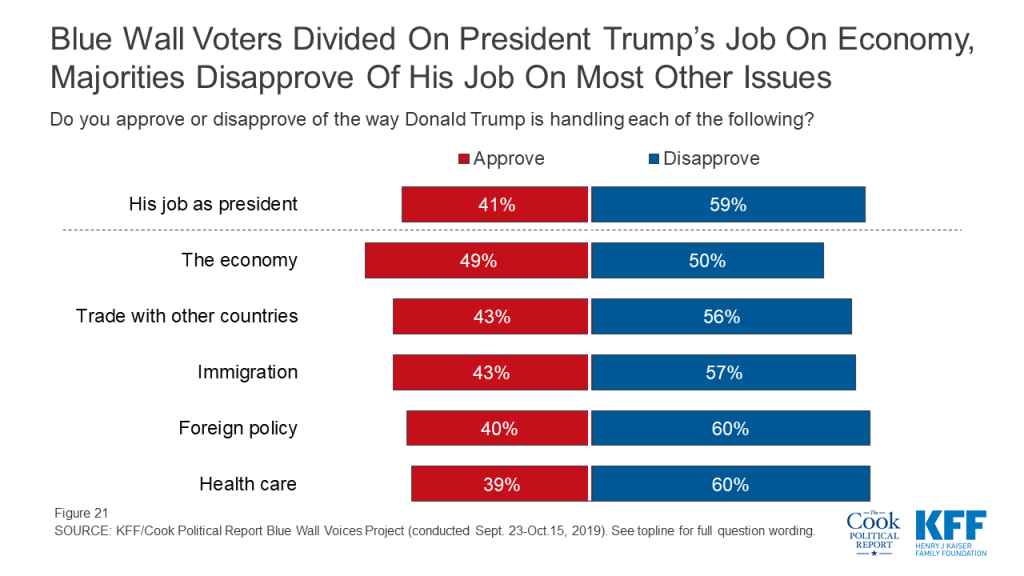
There are, however, unsurprisingly strong partisan differences. Large majorities of Republican voters approve of the job President Trump is doing on all of the issues while independent voters lean more negative in their assessments of President Trump’s job performance. Few Democratic voters approve of his job performance on any of the national issues included in the survey. Across the issues, President Trump ranks best in his handling of the economy with 94% of Republicans approving of the way he is handling the nation’s economy, as do half of independent voters and 11% of Democratic voters.
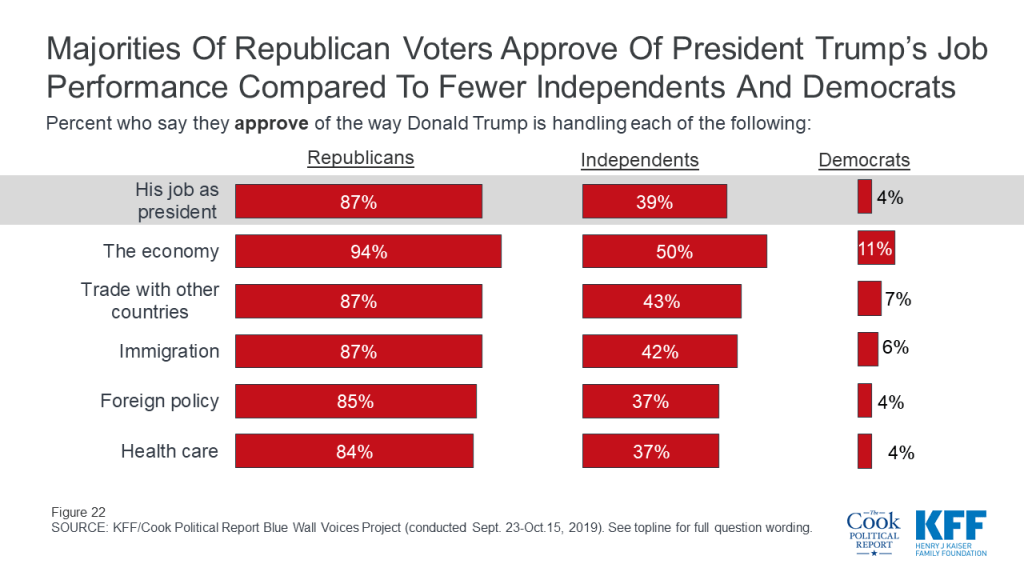
Voters Say Health Care and Economy Are Top Issues
One year out from the 2020 general election, health care and the economy are the top two issues for voters. About one-fifth of voters say health care (21%) or the economy (21%) will be the most important issue in deciding their vote for president next year. These are followed by climate change (14%), gun policy (13%), foreign policy (9%), immigration (9%), taxes (6%), and international trade and tariffs (1%).
An Increased Interest in Foreign Policy?
The Blue Wall Voices Project was conducted September 23rd – October 15th, 2019. Two major foreign policy news stories happened during the field period including the U.S. House of Representatives’ impeachment inquiry and the Turkish invasion into Syria. While news regarding President Trump’s phone call with the Ukrainian President was released prior to the field period, House Speaker Nancy Pelosi announced a formal impeachment inquiry into Trump on September 24th. The news regarding his interactions with foreign leaders remained the top news for the weeks following as testimonies began before House committees. In addition, on October 12th President Trump’s administration announced that U.S. troops would be pulling back from northern Syria, subsequently allowing for Turkey forces to move into a region controlled by the Kurdish forces. Almost immediately, Turkey began assaults against Kurdish fighters and civilians in Syria. This lead to the U.S. to call on Turkey to stop the invasion and announce sanctions aimed at restraining the Turks’ assault. All of these events have led to an increase in the importance of foreign policy among voters in Michigan, Minnesota, Pennsylvania, and Wisconsin. Foreign policy and national security now rank alongside gun policy and immigration as the issues voters say will be the most important in deciding their vote for president next year.
Health care and the economy are the top issues across the Blue Wall states with Minnesota voters also selecting climate change as one of their top issues (17%). To see more about how partisans rank these issues in each state, check out the individual state reports.
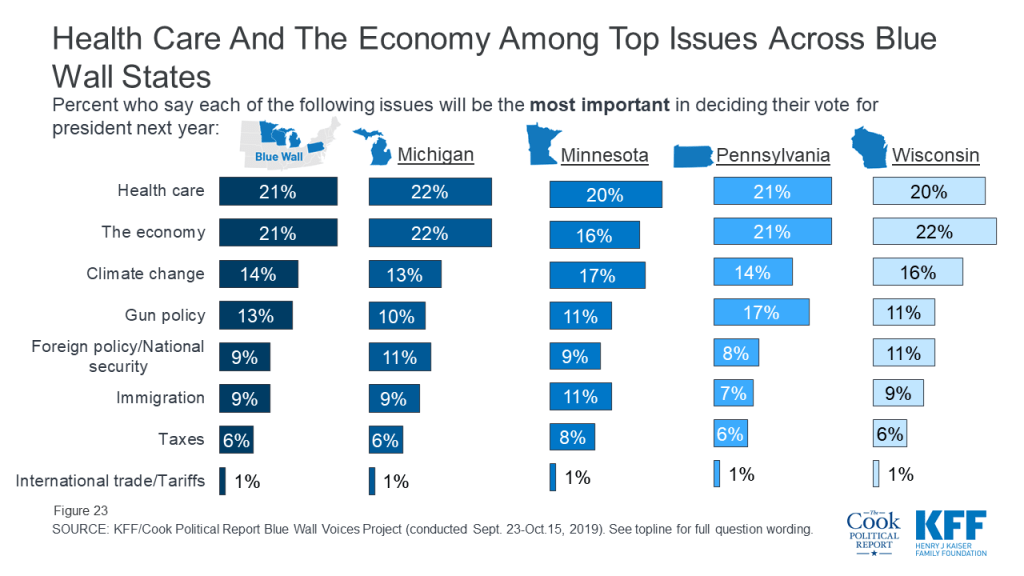
The ranking of issues is largely driven by partisanship. Twice as many Republican voters say the economy will be the most important issue in deciding their vote for President next year than any other issue. Republicans rank the economy (30%), gun policy (15%), and immigration (15%) as the top issues in the presidential election. Democrats rank health care (27%) and climate change (25%) as the top issues. Independent voters choose health care (23%) and the economy (21%) as their top two issues.
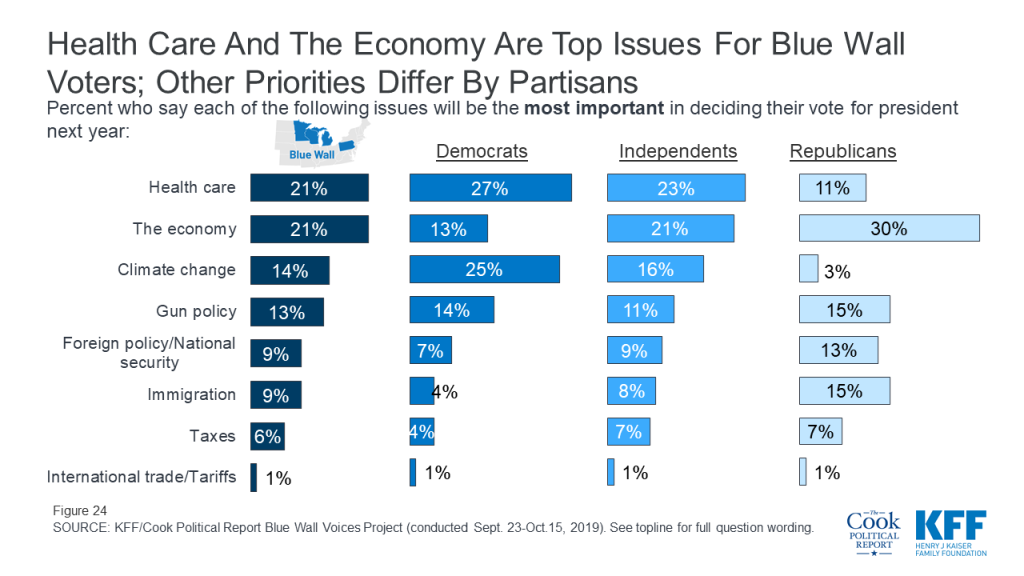
Voters who are still undecided about their 2020 vote choice or haven’t made up their minds yet, our swing voters, rank the issues very similarly with health care and the economy as the top issues they say will be the most important in deciding their vote for president next year. In addition, health care and the economy are the top issues among swing voters in Michigan (23% and 25%), Minnesota (19% and 20%), Pennsylvania (19% and 24%), and Wisconsin (21% and 23%).
Health Care
Lowering prescription drug costs and making sure the ACA’s protections for people with pre-existing health conditions continue are the top health care priorities that voters want to see Congress take on next year. About two-thirds of voters (across states) say lowering prescription drug costs for as many Americans as possible should be a top priority for Congress which is similar to the share who say making sure the ACA’s protections for people with pre-existing conditions should be a top priority. These are the top health care priorities across voters in Michigan, Minnesota, Pennsylvania, and Wisconsin.

Lowering prescription drug costs ranks at the top of the list of health care priorities among all partisans (74% of Democratic voters, 69% of independent voters, and 62% of Republican voters). Making sure the ACA’s protections for people with pre-existing conditions continue is a top priority for both Democrats (83%) and independent voters (65%) while more than half of Republican voters (54%) say repealing and replacing the ACA is a top priority for Congress.

Immigration
Overall, majorities of voters in each of the four states have positive views of immigrants in this country. Most say it is generally true that “immigrants strengthen our country because of their hard work and talents” (72%) and that it is generally not true that “immigrants are a burden on our country because they take their jobs” (81%) or “increase rates of violent crimes in this country” (75%).
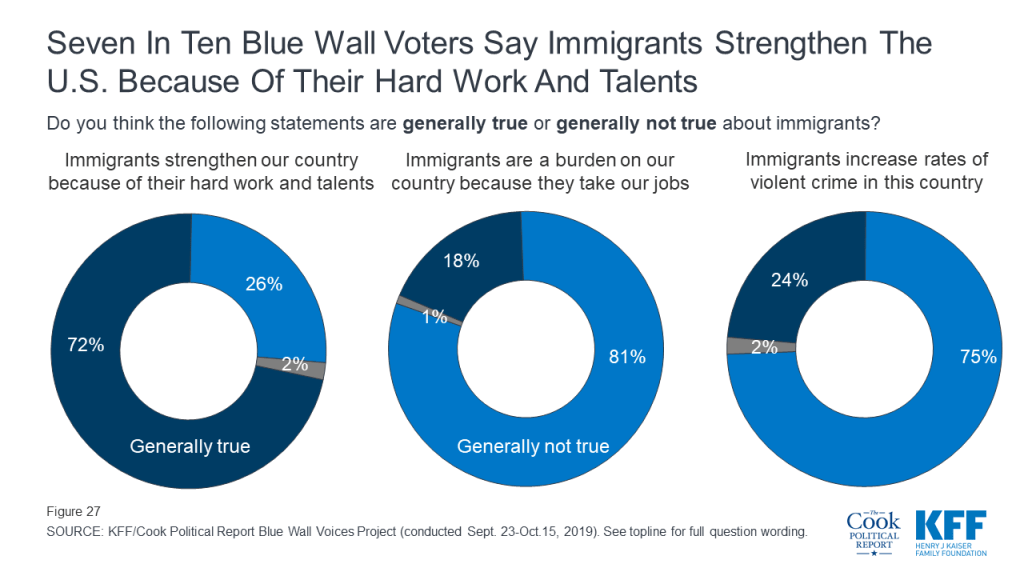
While most Republican voters in Michigan, Minnesota, Pennsylvania, and Wisconsin say that it is generally not true that “immigrants are a burden because they take our jobs,” they are more divided on whether they think “immigrants increase rates of violent crime in this country.” Half of Republican voters say this is generally not true which is similar to the share who say it is generally true (47%).
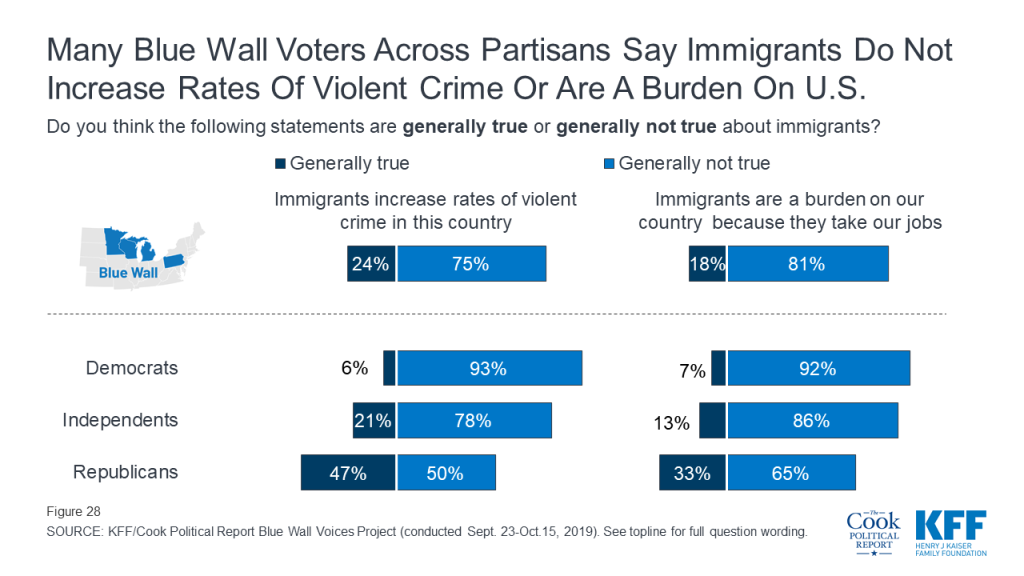
The U.S. Economy
While the economies of each of the states included in the Blue Wall Voices Project are distinct, the views of the economic outlook for the next year as well as views towards the fairness of the economic system are largely similar. The major differences in voters’ perceptions of the U.S. economy are mostly driven by party identification.
Voters are divided along party lines in their economic outlook for the next year with three-fourths (77%) of Democratic voters (across states) saying they expect that during the next 12 months the U.S. will have “bad times” while eight in ten Republicans (81%) say they expect the U.S. will have “good times.” Independent voters are split with similar shares saying they expect that during the next 12 months the U.S. will have good times financially (47%) as bad times (51%).

Views of the fairness current economic system are also largely partisan with larger shares of Democratic voters saying it is more often that “needy people go without government help in American today” (68%) than say it is more often that “irresponsible people get government help they don’t deserve” (30%). Republican voters view the system differently with the vast majority saying it is more often that “irresponsible people get government help they don’t deserve” (84%). A larger share of independent voters also say “irresponsible people getting government help they don’t deserve” happens more often in America today (55%).
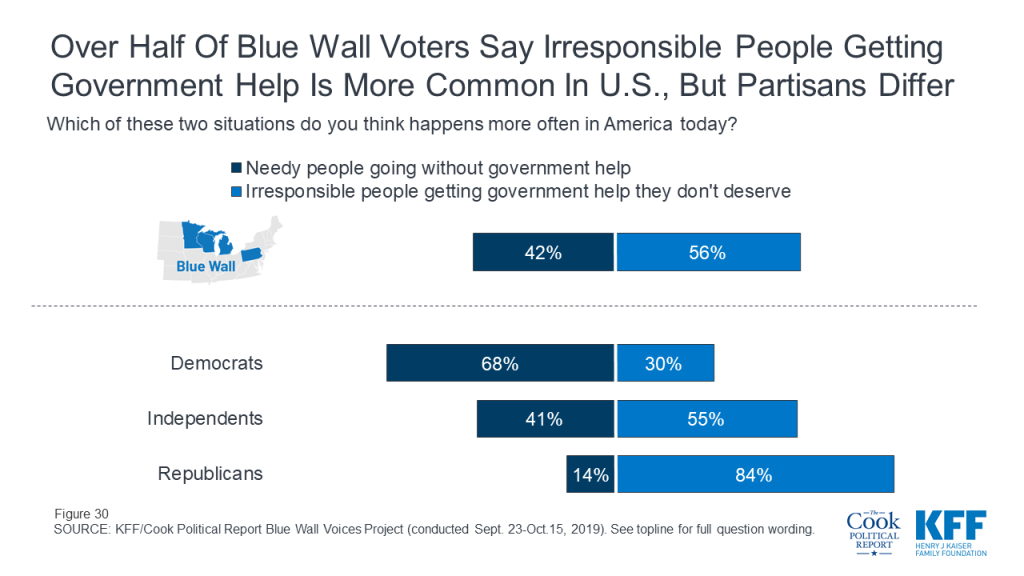
Six in ten voters (62%) say that “unfairness in the economy that favors the wealthy” is a bigger problem in this country while one-third of voters (36%) say “over-regulation that interferes with growth and prosperity” is a bigger problem. Nine in ten Democratic voters (93%) say unfairness in the economy is a bigger problem while seven in ten Republican voters (72%) say over-regulation is a bigger problem. Six in ten (63%) independent voters say unfairness in the economy is a bigger problem while 36% say over-regulation is a bigger problem.
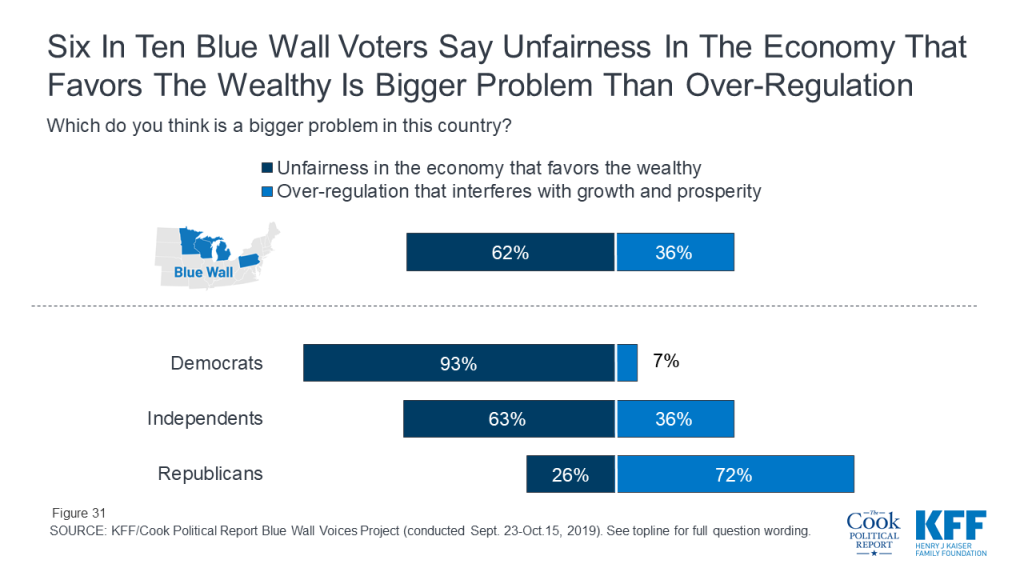
International Trade and Tariffs
With the U.S. engaged in a trade dispute with China and other countries, the Blue Wall Voices project sought to examine voters’ opinions of the possible impacts of the tariffs in Michigan, Minnesota, Pennsylvania, and Wisconsin.
More than half of voters in the Blue Wall say the recent import taxes on certain goods brought into the U.S. from China and other countries will hurt both the national economy (55%) and workers in their state (55%). While these views are largely partisan, about one-fourth of Republican voters say the recent tariffs will hurt both the national economy (23%) and workers in their state (25%).
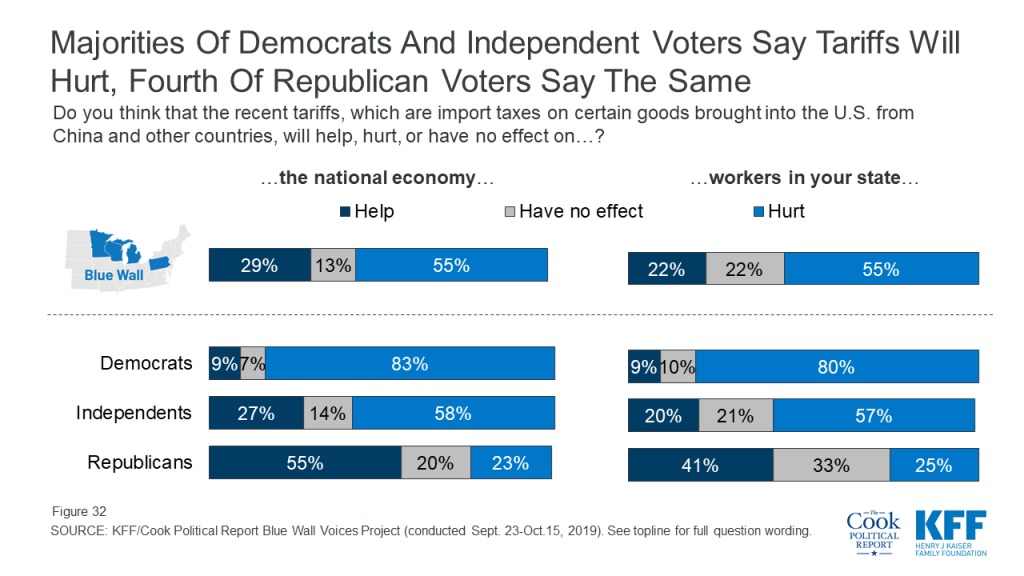
Overall, a larger share of voters in the Blue Wall say the recent tariffs will hurt rather than help them and their families, but a considerable share also say they expect the import taxes to have no effect. More than four in ten voters say the recent tariffs will hurt them and their family including roughly half of voters in Pennsylvania and Wisconsin.

Partisanship plays a large role in views of recent tariffs with seven in ten Democrats (69%) saying the tariffs will hurt them and their families compared to 46% of independent voters and 21% of Republican voters.
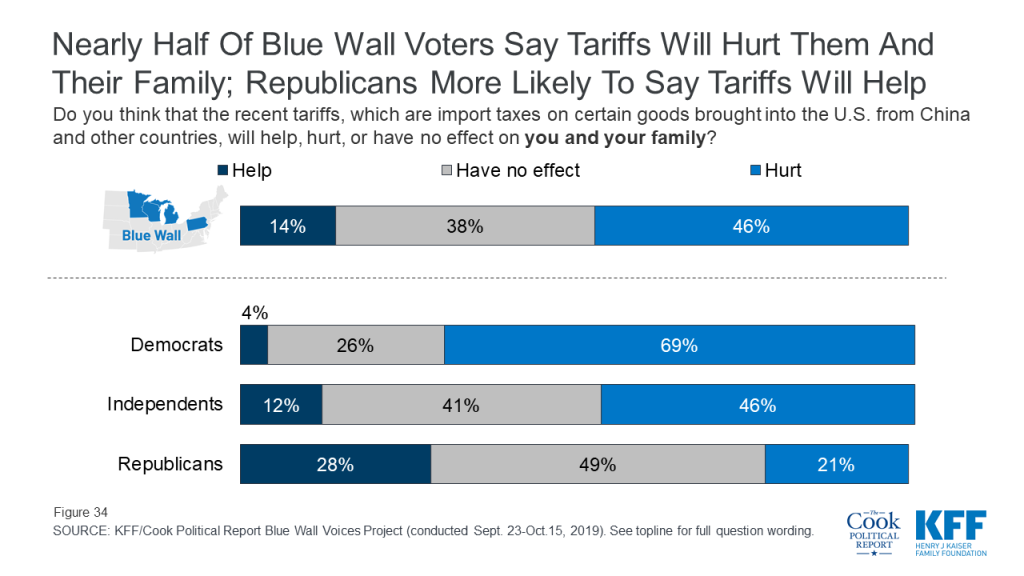
President Trump Currently Has Support Among Rural Voters, But The Economy Matters A Lot To This Group And Many Worry About The Effect Of Recent Tariffs
One key group that President Trump needs to retain support from in 2020 are rural voters. The poll indicates that currently President Trump has the support of rural voters in Michigan, Minnesota, Pennsylvania, and Wisconsin with larger shares of rural voters in each of the states saying they are either “definitely” or “probably” going to vote for President Trump than the Democratic nominee.
| Table 3: President Trump Currently Has Support Among Rural Voters In Upper Midwest | |||||
| TotalRural Voters | MichiganRural Voters | MinnesotaRural Voters | PennsylvaniaRural Voters | WisconsinRural Voters | |
| Definitely voting for President Trump | 32% | 29% | 38% | 35% | 28% |
| Probably going to vote for President Trump | 12 | 13 | 10 | 11 | 13 |
| Undecided | 27 | 29 | 24 | 27 | 27 |
| Probably going to vote for Democratic nominee | 6 | 4 | 7 | 4 | 10 |
| Definitely voting for Democratic nominee | 18 | 18 | 20 | 15 | 20 |
A key issue for this group is the economy with large shares of rural voters in each of the states saying the economy is among the most important issues when deciding their vote next year. And most rural voters approve of the way President Trump is handling the economy with about two-thirds of rural voters in Michigan (66%), Minnesota (65%), Pennsylvania (66%), and Wisconsin (61%) saying they either “strongly approve” or “somewhat approve.” In addition, majorities of rural voters in each state say they expect the U.S. will have good times financially during the next 12 months.
Rural voters are currently less negative in their assessment of how the recent tariffs will hurt workers in their state, the national economy, or their family than suburban and urban voters. But still about half of rural voters say the recent tariffs will hurt workers in their state (47%) and the national economy (45%), while about four in ten (39%) say the recent tariffs will hurt them and their families.
Michigan
The Blue Wall Voices Project examines voters in the state of Michigan to get their perspectives on key issues and aspects of the 2020 election, including the role that health care and the economy may play in voters’ decisions. In addition, it gauges enthusiasm and vote choice leading up to the 2020 presidential election.
Overall, a larger share of Michigan voters say health care and the economy are the most important issues in deciding their vote for president in 2020. About one in five Michigan voters say health care (22%) and the economy (22%) are the most important issues to their vote, with smaller shares saying issues like climate change (13%), foreign policy and national security (11%), gun policy (10%), immigration (9%), taxes (6%), and international trade and tariffs (1%). Partisans are divided in their priorities, with one in four Democrats and independents choosing health care as their top issue, and one-third of Republicans choosing the economy as the most important issue.
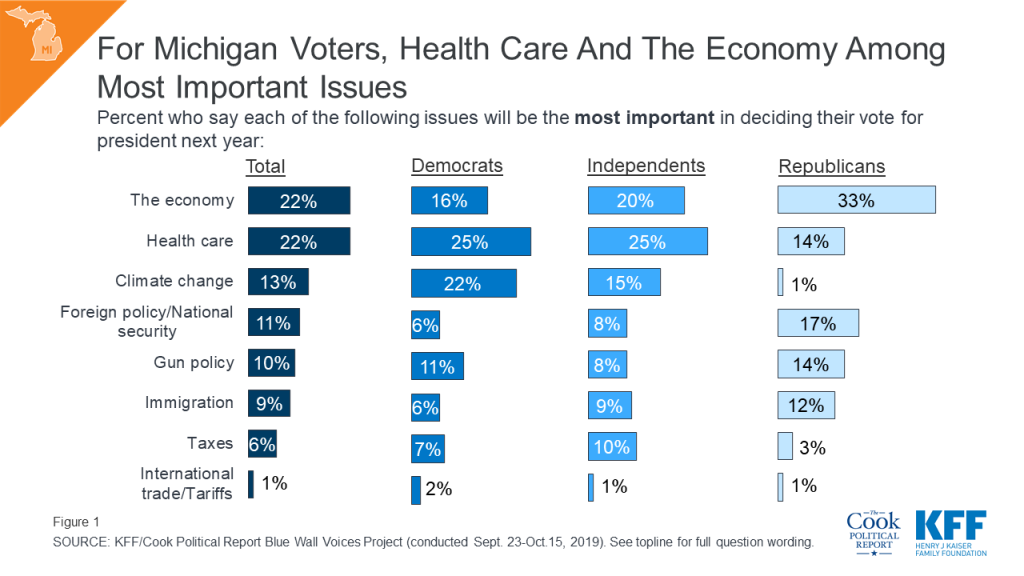
With health care and the economy ranking above all other issues for Michigan voters, it is important to note that Michigan voters give President Trump very different marks on both of these issues. Half (51%) of Michigan voters approve of the way President Trump is handling the economy compared to four in ten (41%) who approve of the way he is handling health care.
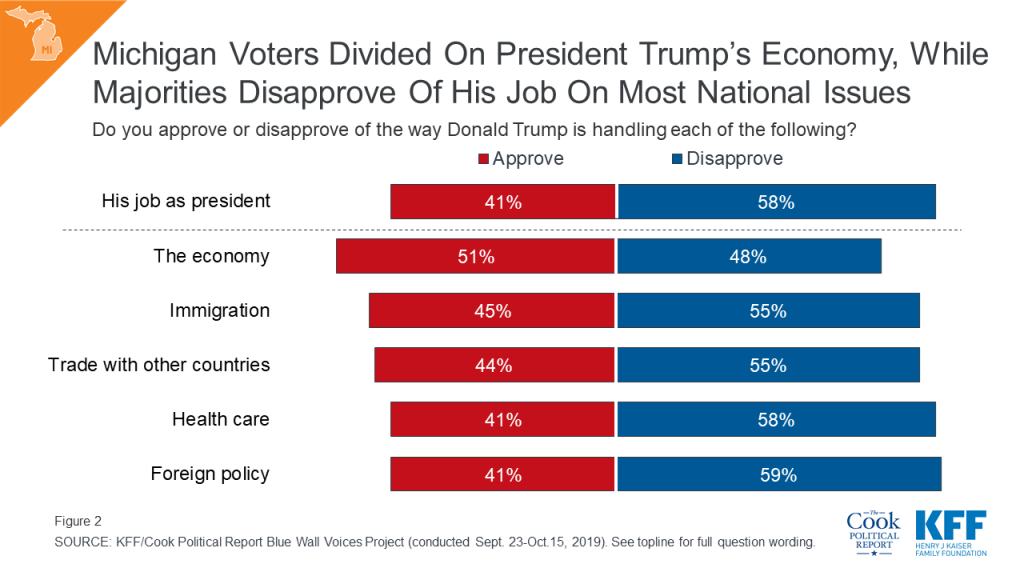
International Trade and Recent Tariffs
While voters do not rank international trade as one of the most important issues in deciding their vote next year, Michigan is a state expected to be most affected by the ongoing trade disputes with China and other countries. Overall, about half of voters – including majorities of Democrats and independents – say they think the recent tariffs will hurt both the national economy (54%) and workers in Michigan (53%). However, this opinion is only shared by about one-fourth of Republican voters (21% and 26%, respectively) compared to majorities of Democrats (80% and 78%, respectively) and independent voters (58% and 57%, respectively). Six in ten Republican voters in Michigan (61%) say the recent tariffs will “help” the national economy and about four in ten (41%) say the tariffs will “help” Michigan workers.

Partisans also differ in how they perceive the recent tariffs will impact them and their families. More than six in ten Democratic voters in Michigan (63%) say the recent tariffs will hurt them and their families while about half of independent voters (47%) and a majority of Republican voters (57%) in the state say they will “have no effect.” Overall, few voters (14%) say the recent tariffs will help them and their families.
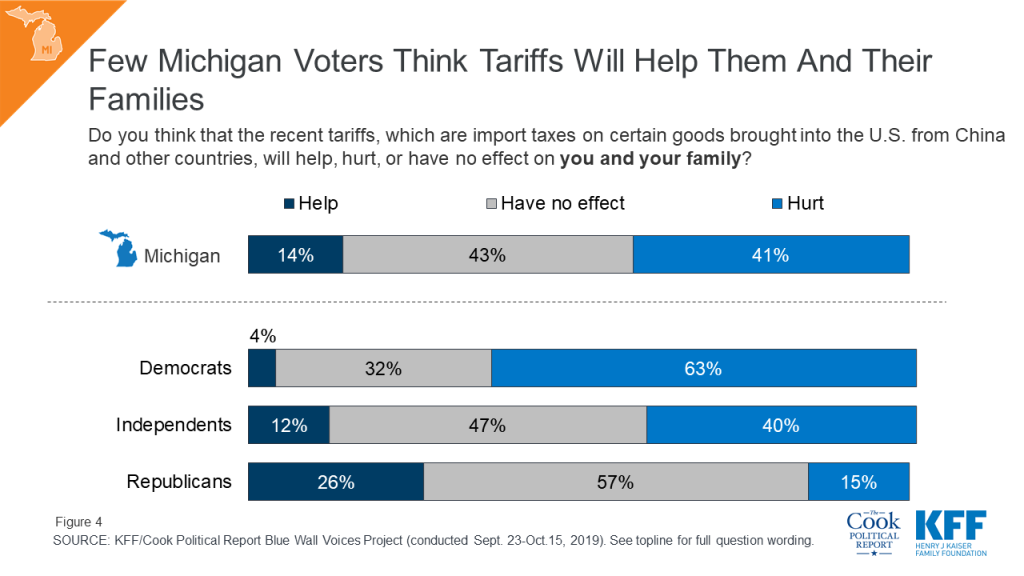
Health Care Priorities among Michigan Voters
When asked specifically about health care priorities that Congress should work on next year, over six in ten say that lowering prescription drug costs (69%) and maintaining protections for people with pre-existing conditions (64%) should be the top priority for Congress. These priorities substantially outrank other policy proposals such as repealing and replacing the ACA, expanding government aid for people who buy their own health insurance, and implementing a public option or national Medicare-for-all plan. These top two priorities persist across partisans, with large shares of Democratic voters, independent voters, and Republican voters naming lowering prescription drug costs and maintaining pre-existing condition protections as top priorities. However, over half of Republican voters (56%) also say that repealing and replacing the ACA should be a top priority. Implementing a national Medicare-for-all plan, a topic that has dominated health care discussions in the 2020 Democratic primary, is not a top issue for all voters or for Democratic voters, specifically.

Michigan Voters’ Economic Outlook
Turning to the economy, the other top issue for voters during the 2020 election, voters in Michigan are split about what they think the economic forecast will be like for the next 12 months. Similar shares of Michigan voters say that during the next 12 months, the U.S. will have bad times (50%) and good times (48%). Views on the economic outlook are largely partisan with roughly eight in ten Democrats (78%) saying bad times are ahead and roughly eight in ten Republicans saying good times are ahead (83%). Independent voters are more divided, with four in ten saying the U.S. will experience “good times” while 54% say they expect “bad times” ahead.
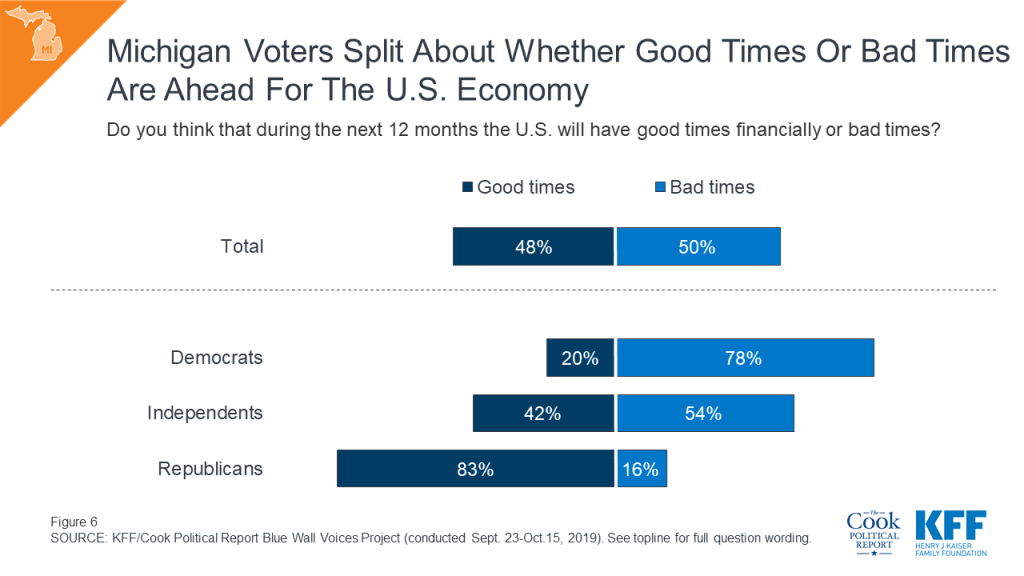
The Democratic Primary in Michigan and Preview of the General Election
More than half of Michigan voters say they are more motivated (55%) to vote in next year’s election than in the previous presidential election. This includes a majority of Democrats (65%), independents (61%) and Republicans (53%) saying they feel more motivated than they did in 2016. Yet, similar to other states included in this analysis, a larger share of Democratic voters say they are “more motivated” than the share of Republican voters who said the same.

Given the high levels of motivation as the next presidential election approaches, the Blue Wall Voices survey explored what could be motivating voters. When asked specifically what the one thing is that will motivate them to vote in the 2020 election, voters offer an array of open-ended responses, with the most frequently volunteered response relating to defeating President Trump (21%), followed by those who offered responses related to civic duty (10%) and health care (8%). Small shares of voters cited reasons such as wanting to re-elect Trump and not wanting to elect a Democrat (6%), or the economy (5%).
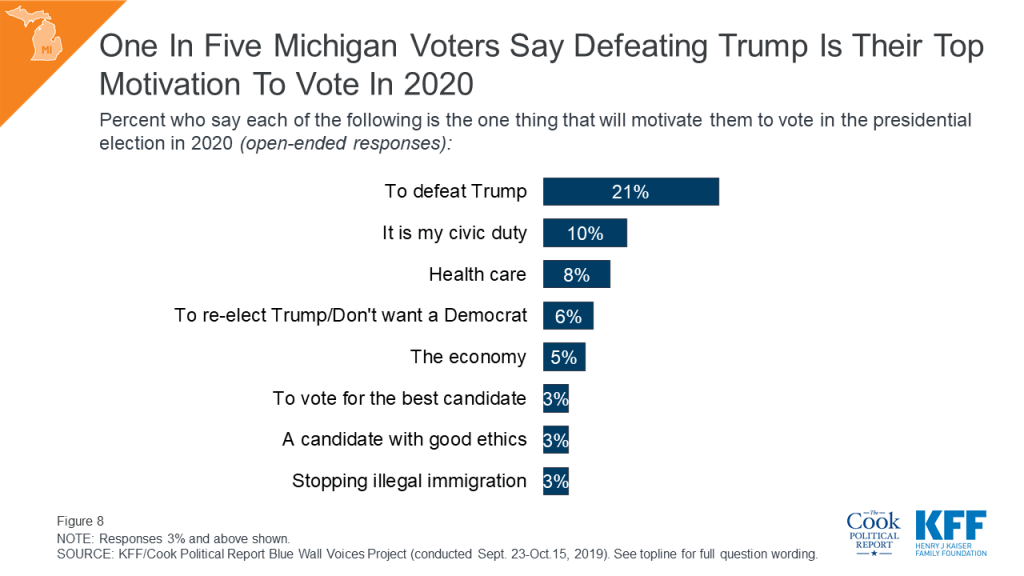
With more than four months before the 2020 Michigan Democratic primary, Senator Elizabeth Warren garners the most support among likely Democratic primary voters followed by Vice President Joe Biden and Senator Bernie Sanders. One-fourth of Michigan Democratic primary voters say Senator Warren is their first choice for the 2020 Democratic ticket and a combined 43% of voters say she is their first choice or second choice.
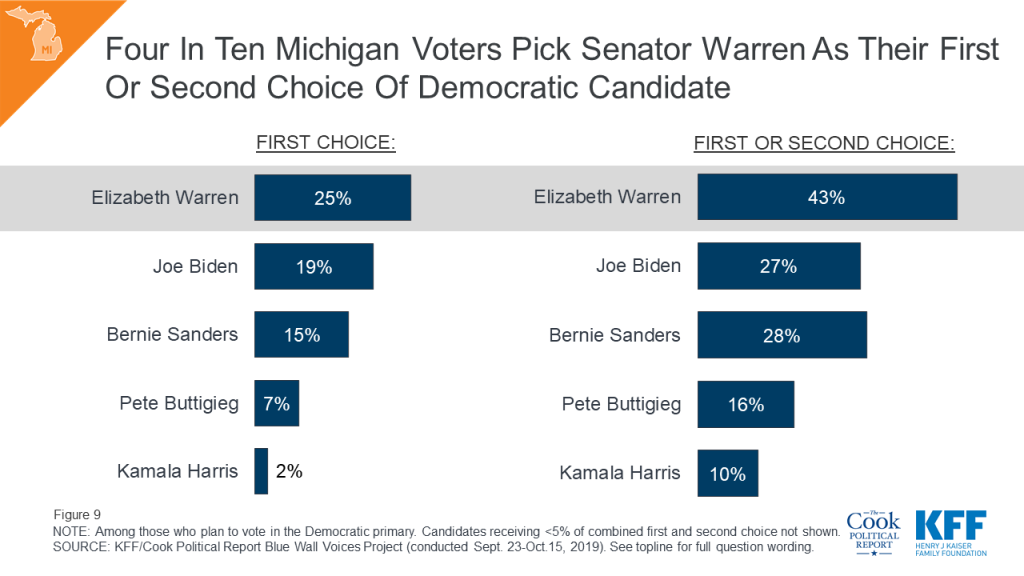
Overall, many voters (43%) in the state remain uncertain about who they will support in the 2020 election. One-third of Michigan voters say they are definitely voting for the Democratic nominee and about one-fifth (21%) say they are definitely voting for President Trump. In contrast, one-fourth of voters say they are undecided, and few voters say they are either probably voting for the Democratic nominee (6%) or for President Trump (11%). This poll finds there are few persuadable Michigan voters meaning that, while they currently support one candidate, they could be convinced to support the other party’s candidate.

Michigan swing voters (those who are either undecided voters or say they are probable but not definite Trump or Democratic voters) are supportive of three progressive platforms: the Green New Deal, a pathway to citizenship for immigrants, and a ban on future sales of assault weapons. But, on the other progressive platforms included in this project, Michigan voters are either split or a majority say they are a bad idea. This includes two-thirds of Michigan swing voters (65%) who say a national Medicare-for-all plan is a “bad idea.”

Minnesota
The Blue Wall Voices Project examines voters in the state of Minnesota to get their perspectives on key issues and aspects of the 2020 election, including the role that health care and the economy may play in voters’ decisions. In addition, it gauges enthusiasm and vote choice leading up to the 2020 presidential election.
Overall, Minnesota voters say that a number of issues will be the most important in deciding their vote for president in 2020, with health care, the economy, and climate change emerging as the top issues. About one in five Minnesota voters say health care (20%), climate change (17%), and the economy (16%), are the most important issues to their vote, with smaller shares naming issues like gun policy (11%), immigration (11%), foreign policy and national security (9%), taxes (8%), and international trade and tariffs (1%). Partisans are divided in their priorities with three in ten Democrats ranking health care and climate change as their top issues, about two in ten independents ranking health care and the economy as their top issues, and one-fourth of Republicans ranking the economy as the most important issue and one in five saying immigration will be the most important issue in deciding their 2020 vote choice.
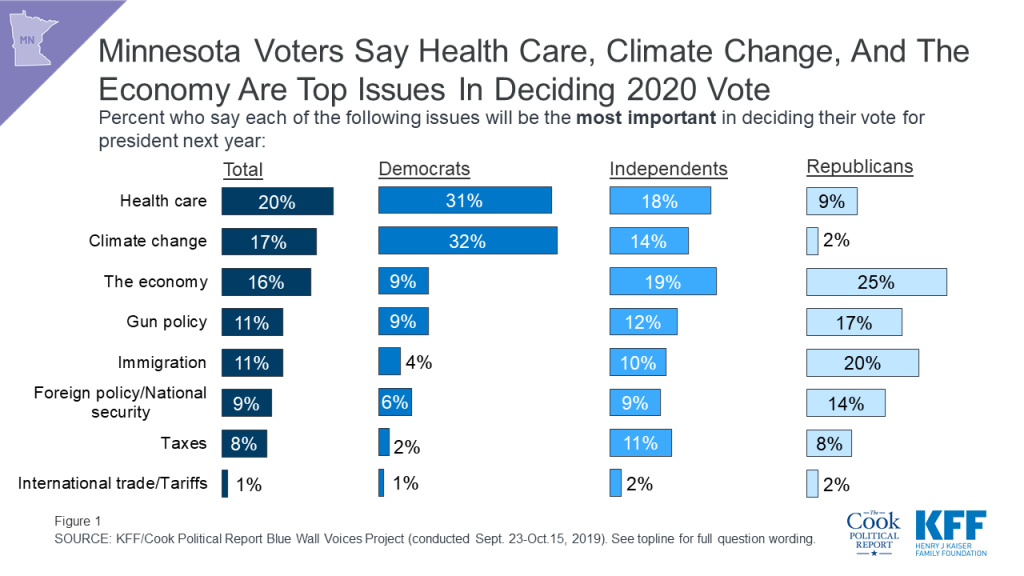
Overall, a majority of Minnesota voters disapprove of President Trump’s job performance (58%) while four in ten voters approve (42%). In addition, most Minnesota voters also disapprove of the way he is handling foreign policy (58%), health care (57%), immigration (56%), and trade with other countries (55%). Minnesota voters are more divided in their views of how President Trump is handling the economy with 49% of voters saying they approve compared to 51% who disapprove.
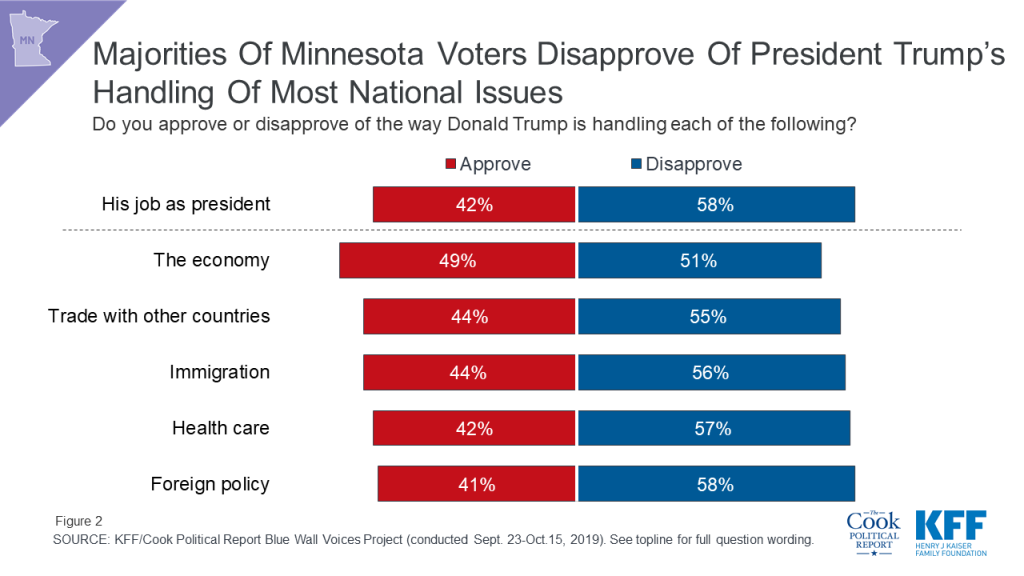
Minnesota Voters on Health Care Priorities
When asked specifically about health care priorities that Congress could work on next year, over six in ten say lowering prescription drug costs (64%) and maintaining protections for people with pre-existing conditions (62%) should be the top priority for Congress. These priorities substantially outrank other policy proposals such as repealing and replacing the Affordable Care Act (28%), expanding government financial help for people who buy their own health insurance coverage on the ACA marketplace to include more people (21%), and implementing a public option (23%) or national Medicare-for-all plan (20%). These top two priorities persist across partisans, with large shares of Democratic, independent, and Republican voters naming lowering prescription drug costs and maintaining pre-existing condition protections as top priorities. However, over half of Republican voters (53%) also say that repealing and replacing the ACA should be a top priority. Implementing a national Medicare-for-all plan, a topic that has dominated health care discussions in the 2020 Democratic primary, is not a top priority for a majority of voters or for Democratic voters, specifically.
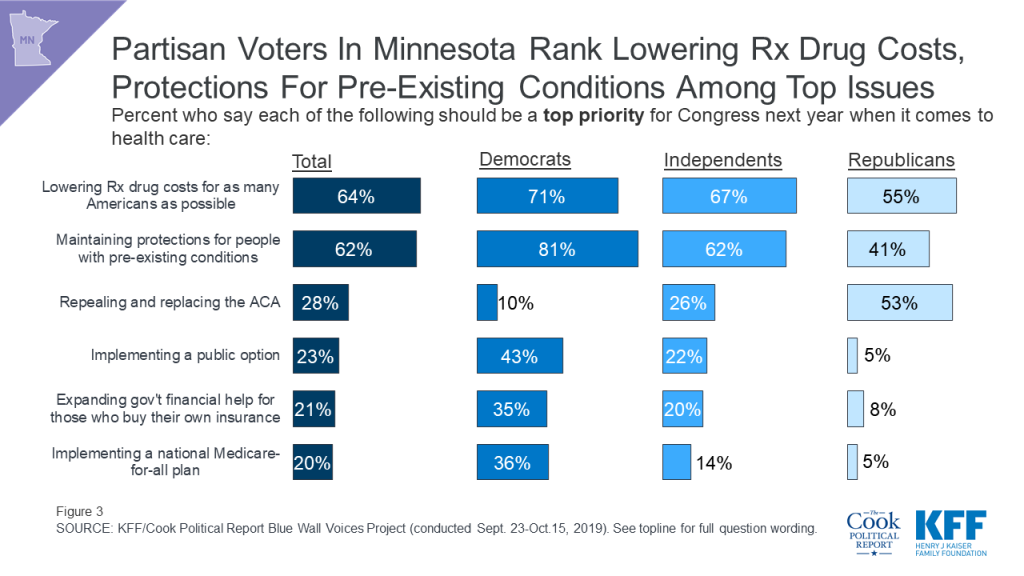
Minnesota Voters’ Views of the U.S. Economy
Turning to the economy, the other top issue for voters during the 2020 election, Minnesota voters are optimistic about the U.S. economic forecast over the next 12 months. About half of Minnesota voters say that during the next 12 months, the U.S. will have “good times” (53%), compared to a slightly smaller share who say the U.S. will experience “bad times” (44%). Views towards the U.S. economy are largely partisan with two-thirds of Democrats (68%) saying bad times are ahead, while over eight in ten Republicans (84%) say the U.S. will experience “good times” financially. Independent voters are more divided, but lean positive with 54% saying they expect “good times,” while 44% say the U.S. economy will experience “bad times” over the next year.

The Democratic Primary in Minnesota and Preview of the General Election
Slightly over half of Minnesota voters say they are more motivated (52%) to vote in next year’s election than in the previous presidential election. This includes majorities of Democrats (57%) and Republicans (59%) and nearly half of independents (47%) saying they feel more motivated than they did in 2016.
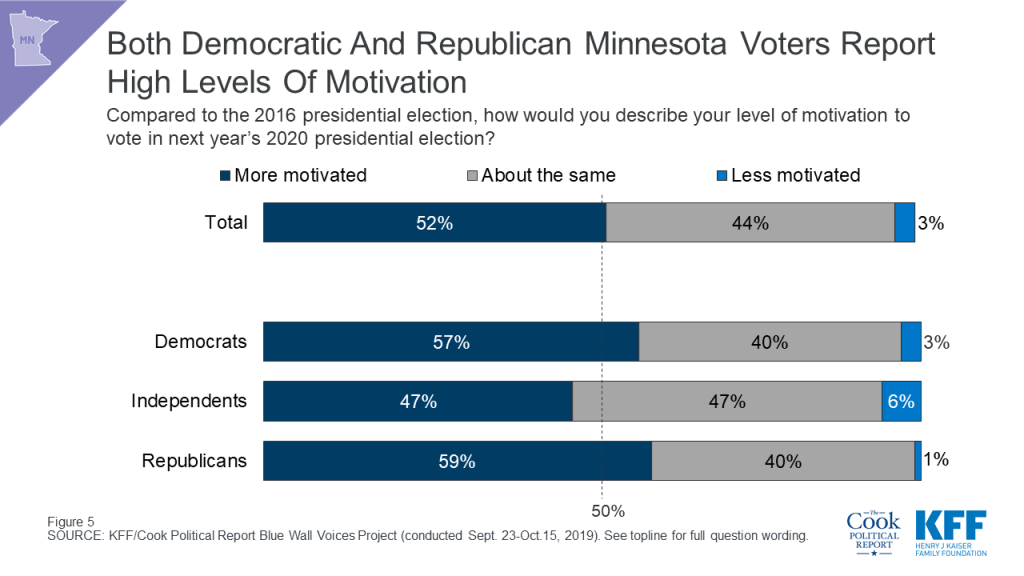
Given the high levels of motivation as the next presidential election approaches, the Blue Wall Voices survey explored what could be motivating voters. When asked specifically what the one thing is that will motivate them to vote in the 2020 election, voters offer an array of responses, with the most frequently volunteered response related to defeating Trump (18%), followed by those who offered responses related to civic duty (11%). Smaller shares cite reasons such as to re-elect Trump or not wanting a Democrat (9%), health care (6%), a candidate with good ethics (4%), and the environment or climate change (4%).

With more than four months left before the 2020 Minnesota Democratic primary, Senator Elizabeth Warren garners the most support among likely Democratic primary voters followed by Minnesota Senator Amy Klobuchar, Vice President Joe Biden, and Senator Bernie Sanders. One-fourth of Minnesota Democratic primary voters say Senator Warren is their first choice for the 2020 Democratic ticket and a combined 43% of voters say she is their first choice or second choice.
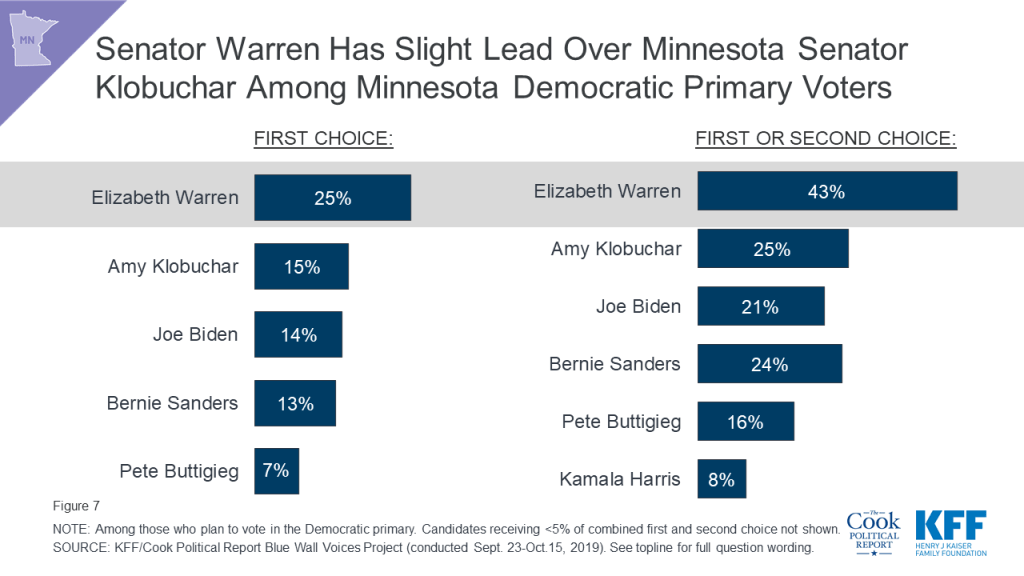
About one-third of Minnesota voters say they are “definitely voting for the Democratic nominee” (32%) and about one-fourth (24%) say they are “definitely voting for President Trump.” Many voters (41%) in the state remain uncertain about who they will support in the 2020 general election. Of that 41%, two in ten voters say they are “undecided” (21%), and about one in ten say they are either “probably voting for the Democratic nominee” (10%) or “probably voting for President Trump” (10%). This poll finds few persuadable Minnesota voters, meaning that, while they currently support one candidate, they could be convinced to support the other party’s candidate. Three percent of all Minnesota voters say that they are probably going to vote for President Trump, but there is “a chance” they will vote for the Democratic nominee. On the other side, 1% of Minnesota voters say that they are probably voting for the Democratic nominee, but there is “a chance” they will vote for President Trump.
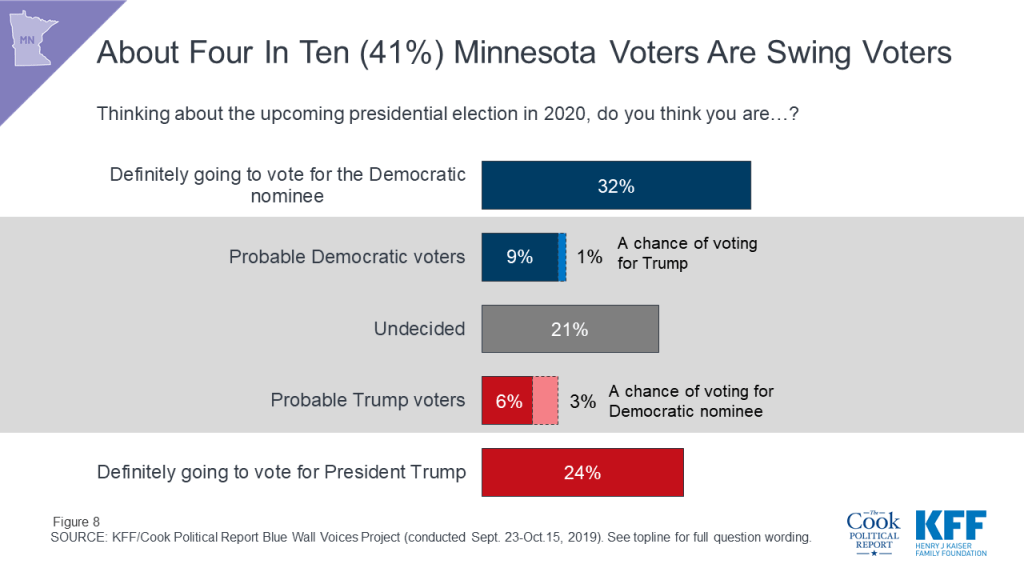
Minnesota swing voters (those who are undecided or say they are probably going to vote for either President Trump or the Democratic nominee) have very different views on two key immigration issues. While three-fourths of Minnesota swing voters (76%) think a pathway to citizenship for immigrants who are in the country illegally is a “good idea,” two-thirds think stopping detainments at the U.S. border for people who are coming into the country illegally is a “bad idea.”
On other progressive platforms, Minnesota swing voters have positive views towards a ban on future sales of assault weapons (68%) and a Green New Deal that would address climate change through new regulations and increases in government spending on green jobs and energy-efficient infrastructure (64%), but say a national Medicare-for all plan is a “bad idea” (63%). Minnesota swing voters are more divided in their views towards a ban on owning assault weapons including a mandatory buyback program (54% say it is a “good idea,” while 46% say it is a “bad idea”) and a ban on fracking (42% say it is a “good idea,” while 50% say it is a “bad idea”).

Pennsylvania
The Blue Wall Voices Project examines voters in Pennsylvania, a state that President Trump won by less than one percentage point (approximately 44,000 votes) over Democratic candidate Hillary Clinton in 2016. This poll finds that health care is among the top issues for voters more than one year out from the general election and examines enthusiasm and vote choice leading up to the 2020 presidential election.
Health care ranks among the top issues for voters leading up to the 2020 presidential election along with the economy, gun policy, and climate change. Health care is the top issue for Democratic voters (28%) and ranks among the top issue for independent voters (25%), but ranks lower among Republican voters. In fact, among Republican voters, health care ranks below the economy (31%), gun policy (16%), and immigration (14%), and alongside foreign policy or national security (9%) and taxes (9%), with one in ten Republican voters saying health care will be the most important issue in deciding their vote next year.
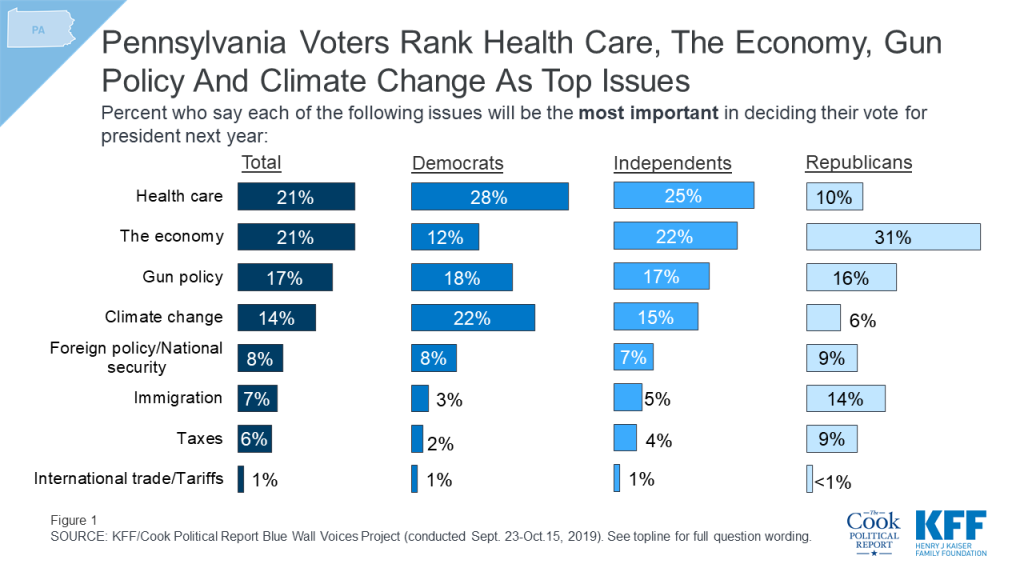
Similar to the overall Blue Wall, Pennsylvania voters are most positive in their views of the way President Trump has handled the economy with nearly half (48%) of Pennsylvania voters saying they approve of his job performance on this issue. On the other hand, more than six in ten Pennsylvania voters (63%) say they disapprove of the way he has handled health care. Both of these issues appear to be key issues leading up to the 2020 presidential race.
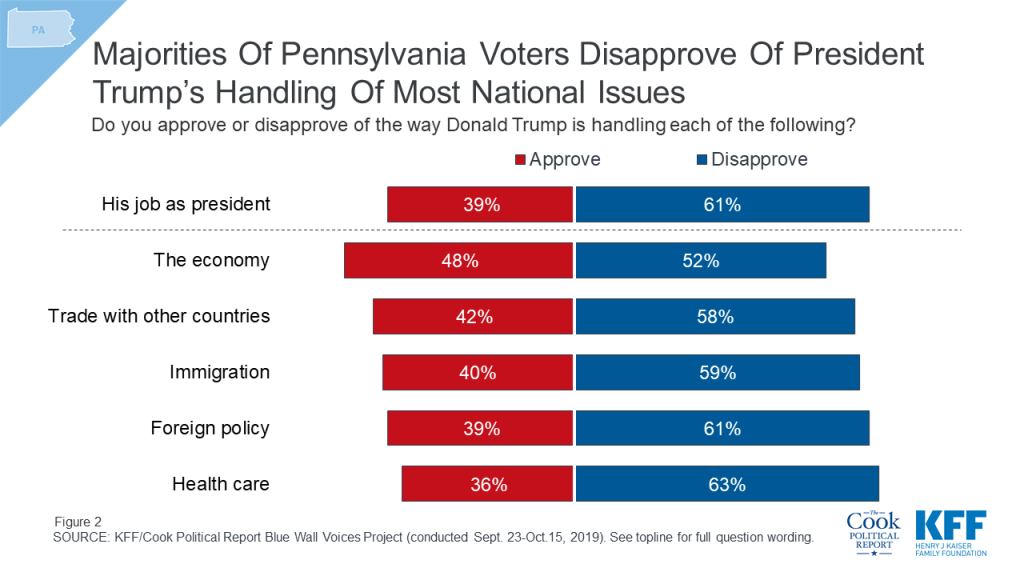
Pennsylvania Voters on Health Care
While Medicare-for-all has dominated most of the health care discussions on the 2020 Democratic campaign trail, it ranks low among the priorities that the public has for Congress next year. One-fourth (26%) of Pennsylvania voters say implementing a national Medicare-for-all plan is a “top priority” for Congress compared to nearly seven in ten who say the same about lowering prescription drug costs for as many Americans as possible (68%) as well as maintaining the Affordable Care Act’s protections for people with pre-existing medical conditions (68%). Implementing a national Medicare-for-all plan is not even a top priority among Democratic voters (36%).

The Economy
The economy is another top issue for Pennsylvania voters but views of how the economy will fare over the next 12 months are largely driven by partisanship. Overall, voters in Pennsylvania are divided with similar shares saying they think that the U.S. will experience “good times” (47%) and “bad times” (51%) over the next 12 months. Eight in ten (78%) Democratic voters say the U.S. will have bad times financially over the next year while 80% of Republicans say the U.S. will have good times. Independents are evenly divided (49% v. 49%).
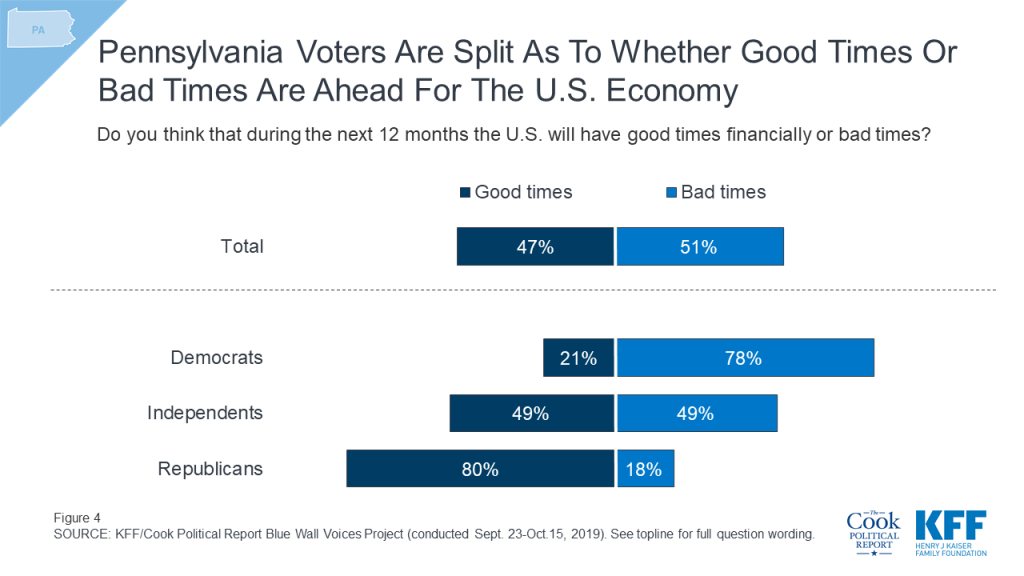
The Democratic Primary in Pennsylvania and Preview of the General Election
Two-thirds of Democratic voters say they are more motivated to vote in next year’s 2020 presidential election than they were in 2016 compared to slightly more than half of independent voters (54%) and Republican voters (54%). This is similar to the overall Blue Wall findings, which finds the Democratic Party has a slight enthusiasm edge over their Republican counterparts.
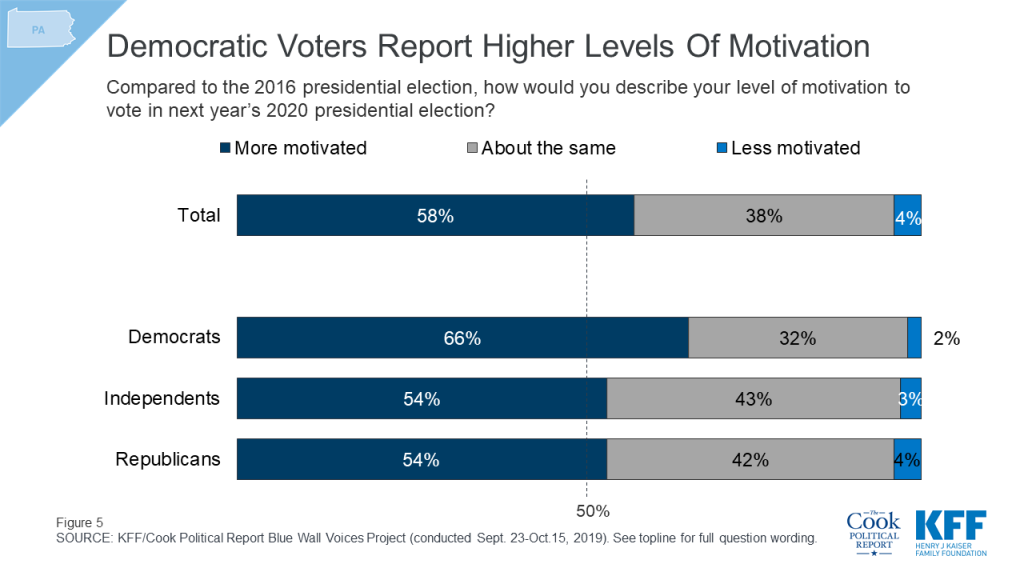
When asked to say in their own words what will be the one thing that will motivate them to vote in the 2020 presidential election, a larger share of voters offer responses related to defeating President Trump than any other thing. One-fifth of voters say defeating President Trump (22%) is the one thing that will motivate them to vote next year, followed by those who say they are motivated by re-electing President Trump or not wanting to elect a Democrat (10%), the issue of health care (8%), or their civic duty (7%).
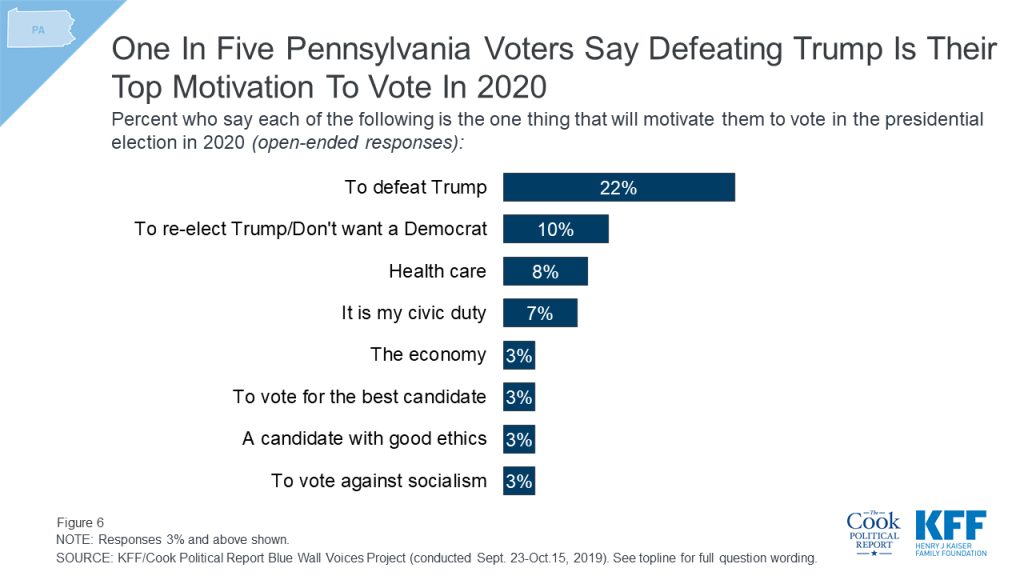
With more than six months before the Pennsylvania Democratic primary, Vice President Joe Biden, a Pennsylvania native, is the first choice among Democratic primary voters. One-fourth (27%) of Democratic primary voters chose Vice President Biden as their first choice of 2020 Democratic candidates followed by 18% of Democratic primary voters who chose Senator Elizabeth Warren and 14% who chose Senator Bernie Sanders. Senator Warren and Vice President Biden have a relatively similar share of first choice and second choice votes with more than one-third of voters selecting either candidate as their first or second choice.
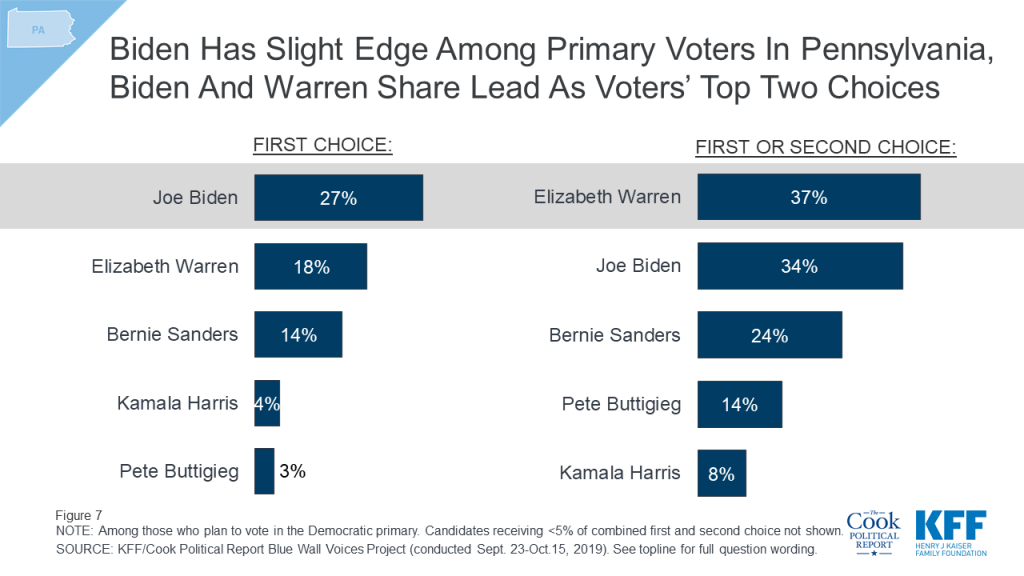
Nearly four in ten (39%) Pennsylvania voters are still either undecided (22%) about their 2020 vote choice, or say they are “probably” voting for either President Trump (10%) or the Democratic nominee (7%) but have not made up their minds yet. This is compared to one-third of voters who say they are “definitely voting” for the Democratic nominee and one-fourth who are “definitely voting” for President Trump (23%).
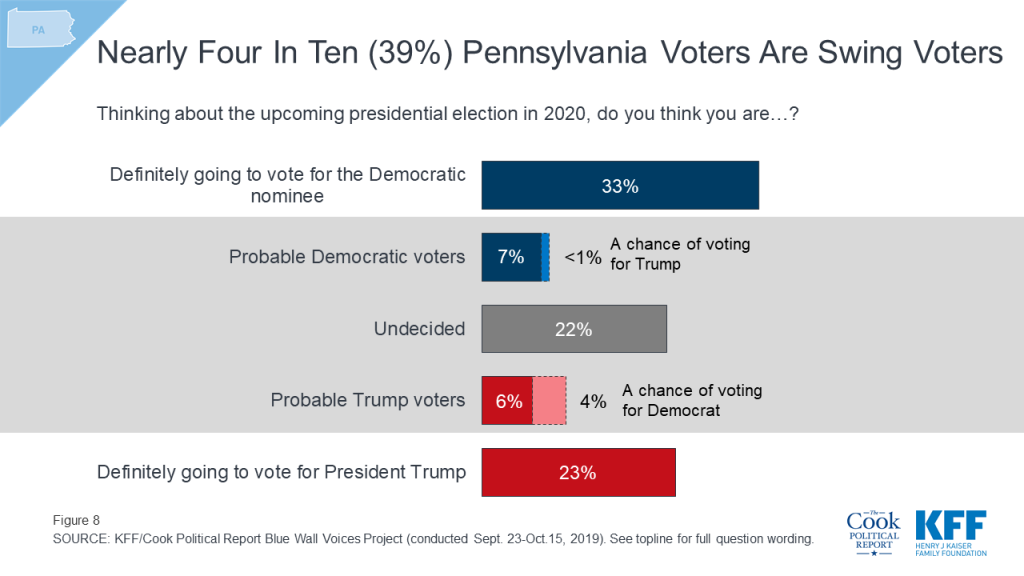
With four in ten Pennsylvania votes still up for grabs, the poll finds that majorities of Pennsylvania swing voters (those who either say are still undecided or are either probable but not definite Trump or Democratic voters) say many of the progressive platforms currently being discussed in the Democratic primary are good ideas, but these voters are less positive in their views of three important policy positions, including Medicare-for-all. More than half of Pennsylvania swing voters say a pathway to citizenship for immigrants in the country illegally (72%), the Green New Deal (69%), a ban on future sales of assault weapons (67%), and a ban on owning assault weapons (57%) are good ideas. On the other hand, Pennsylvania swing voters are more negative in views of a national Medicare-for-all plan, fracking, and no longer detaining people for crossing the U.S. border illegally. Majorities of Pennsylvania swing voters say all three of these progressive platforms, a national Medicare-for-all plan (56%), a ban on fracking (57%), and stopping U.S. border detainments (72%), are “bad ideas.”

Wisconsin
The Blue Wall Voices Project examines voters in Wisconsin, a state that President Trump won by less than one percentage point over Democratic candidate Hillary Clinton in 2016. This poll finds the economy and health care are among the top issues for voters more than one year out from the general election and examines enthusiasm and vote choice leading up to the 2020 presidential election.
With approximately one year before the 2020 presidential election, the economy (22%) and health care (20%) emerge as the top issues for Wisconsin voters. Smaller shares name climate change (16%), gun policy (11%), foreign policy or national security (11%) and immigration (9%) as the issue which will be most important in deciding their vote. However, there are notable partisan differences on which issues are most important in deciding their vote. Among Democrats, climate change emerges as a top issue with nearly three in ten (29%) saying it will be the most important issue in deciding their vote, while among Republicans, only 2% say climate change is the most important issue. Nearly three in ten Republicans (29%) say the economy is the most important issue, compared to 22% of independents and 12% of Democrats. Larger shares of Democratic voters and independent voters say health care is the most important issue in deciding their vote (25% and 21%, respectively) than Republican voters (13%).
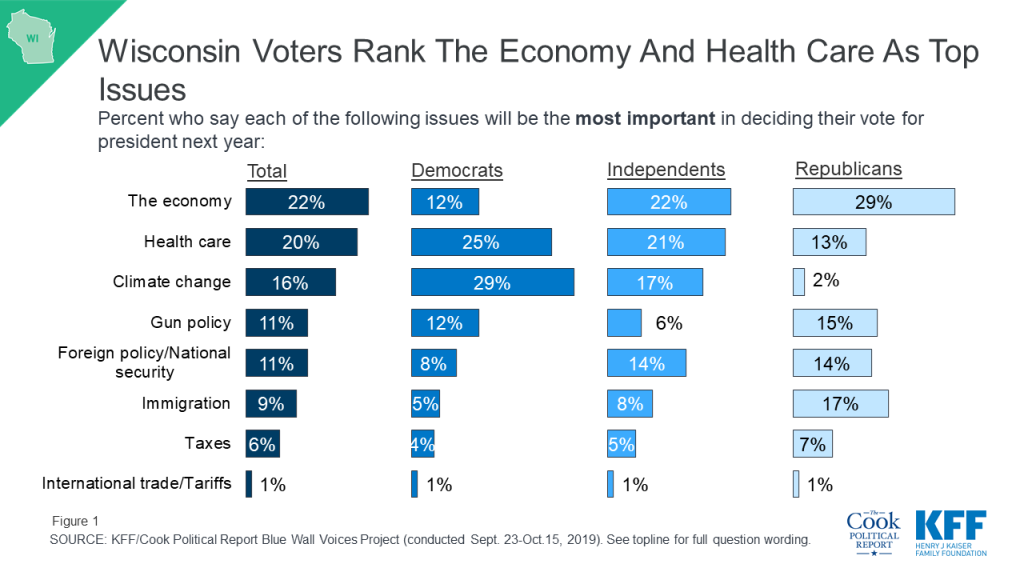
While Wisconsin voters are evenly divided in their views of how President Trump is handling the economy (50% v. 50%), a larger share of Wisconsin voters give President Trump negative marks on all other issues included in this poll including foreign policy (60%), health care (58%), immigration (58%), and international trade (57%).
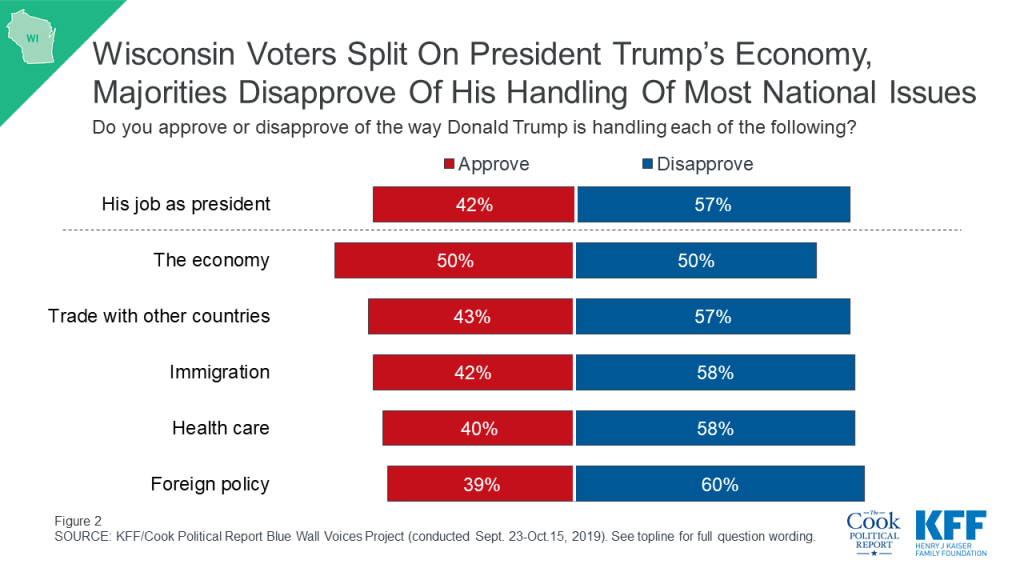
Wisconsin Voters’ Views of Health Care Priorities
When asked about specific health care priorities for Congress to work on next year, nearly seven in ten Wisconsin voters say lowering prescription drug costs (69%) and maintaining protections for people with pre-existing conditions (66%) should be “a top priority.” Majorities of Democrats (79%), independents (70%), and Republicans (59%) say lowering prescription drug costs should be a top priority for Congress. A majority of Republicans (57%) say repealing and replacing the ACA should be a top priority while a smaller share (46%) say maintaining protections for people with pre-existing conditions should be a top priority for Congress. With discussions about Medicare-for-all dominating the health care conversation in the recent Democratic primary debates, equal shares of Wisconsin Democratic voters say implementing a national Medicare-for-all plan and implementing a public option should be a top priority for Congress next year (43% each), mirroring the policy divide on this issue among the leading Democratic candidates.
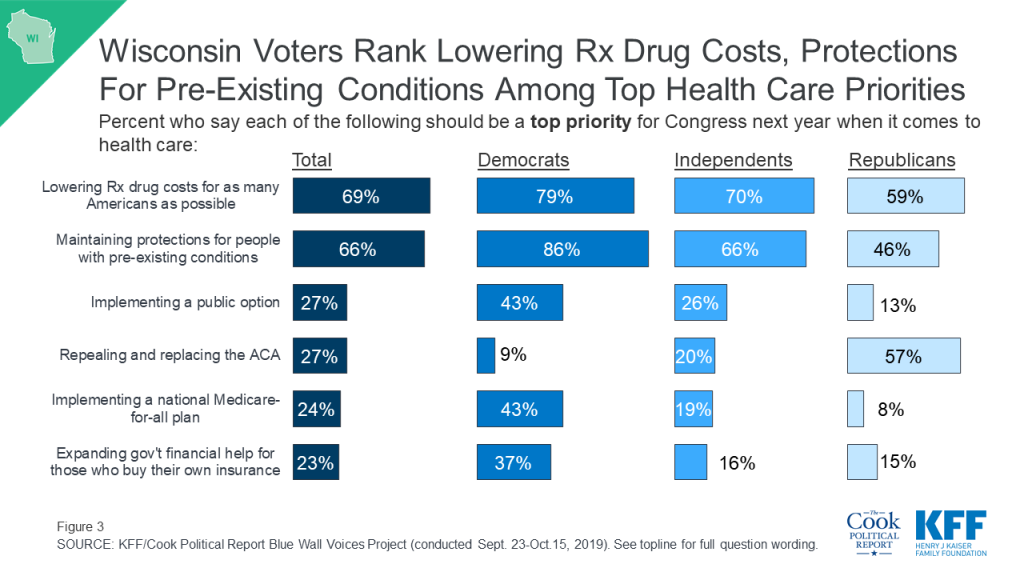
The Economy
Wisconsin voters are divided in their economic outlook for the country in the next 12 months. About half (51%) think the U.S. will have “bad times” financially in the next year while 47% expect “good times.” There is a stark partisan divide with eight in ten Democrats expecting bad economic times in the next year, whereas three in four Republicans (77%) expect good times financially for the country. Similar shares of independent voters expect bad economic times (52%) and good times financially (46%).
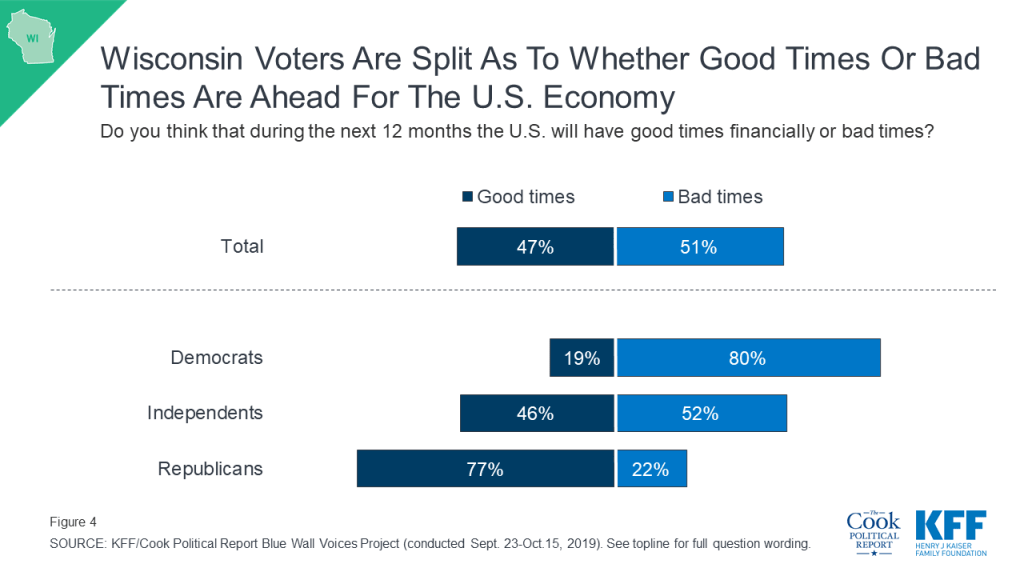
The Democratic Primary in Wisconsin and Preview of the General Election
About half of Wisconsin voters (51%) say they are more motivated to vote in 2020 than they were in the 2016 presidential election. Democrats seem to have the edge when it comes to motivation with more than six in ten Democrats (62%) saying they are “more motivated” to vote in 2020 than they were last election compared to less than half of Republicans (46%) who say they are more motivated.

When asked specifically what one thing will motivate them to vote in the 2020 election, the most frequently volunteered response was defeating President Trump (19%). Smaller shares cited reasons such as a sense of civic duty (9%), re-electing President Trump or not wanting to elect a Democrat (8%), health care (6%), the economy (5%), and to vote for the best candidate (4%) or a candidate with good ethics (4%).
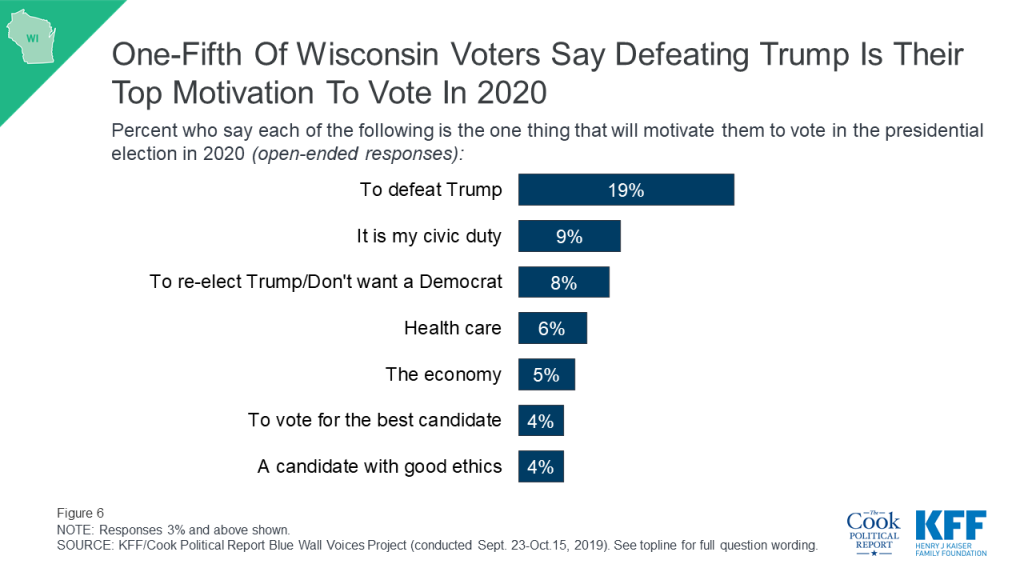
With about five months before Wisconsin’s 2020 primary election, about one in five Democratic voters say Senator Warren (22%) and Vice President Biden (17%) are who they plan to support during the Democratic primary. Vermont Senator Bernie Sanders, who won the Wisconsin primary in 2016 when he challenged former Senator Hillary Clinton for the nomination, is currently garnering 10%. Notably, about four in ten (41%) Wisconsin Democratic primary voters select Senator Warren as their first or second choice compared to one in four Democratic primary voters who select Vice President Joe Biden as their first or second choice while one in five (21%) say Senator Sanders is their first or second choice.
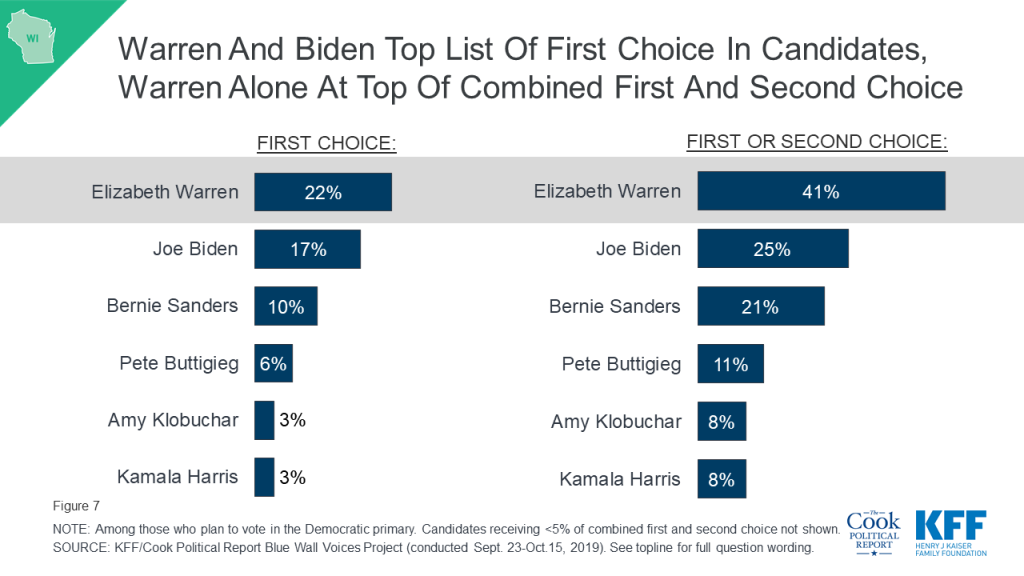
About four in ten (43%) Wisconsin voters are either undecided (21%) about their 2020 vote choice or say they are “probably” voting for either President Trump (11%) or the Democratic nominee (10%) but have not made up their minds yet. About three in ten voters say they are “definitely voting” for the Democratic nominee (31%) and about one in five say they are “definitely voting” for President Trump (22%).
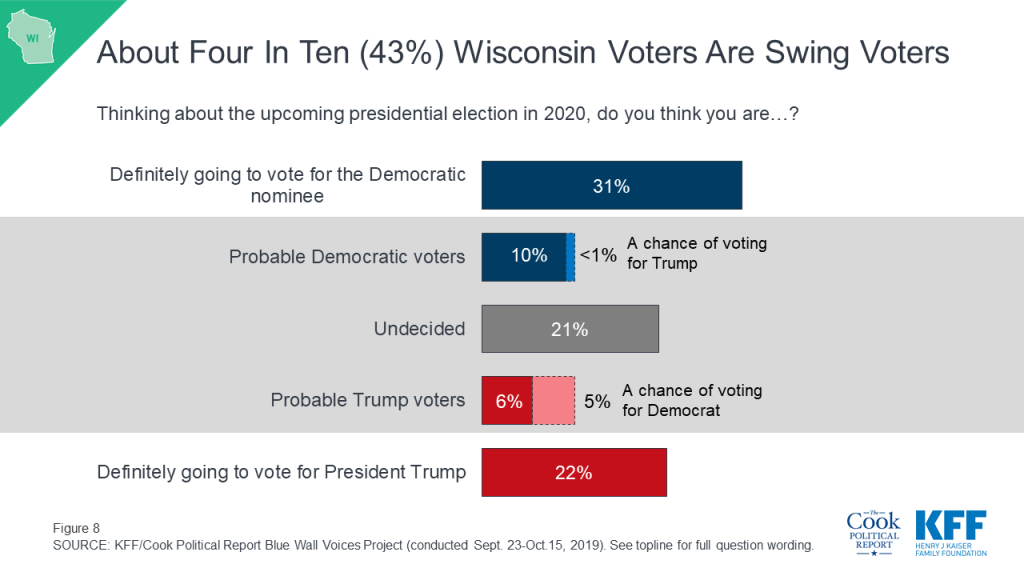
Majorities of Wisconsin swing voters (those who are either undecided or say they are probably going to vote for either president Trump or the Democratic nominee) say many of the progressive platforms are “good ideas” including a pathway to citizenship for immigrants in the U.S. illegally (75%), a Green New Deal (65%), and a ban on future sales of assault weapons (65%). But most Wisconsin swing voters say a ban on fracking (55%), a national Medicare-for-all plan (63%), and stopping detainments at the U.S. border (66%) are bad ideas.
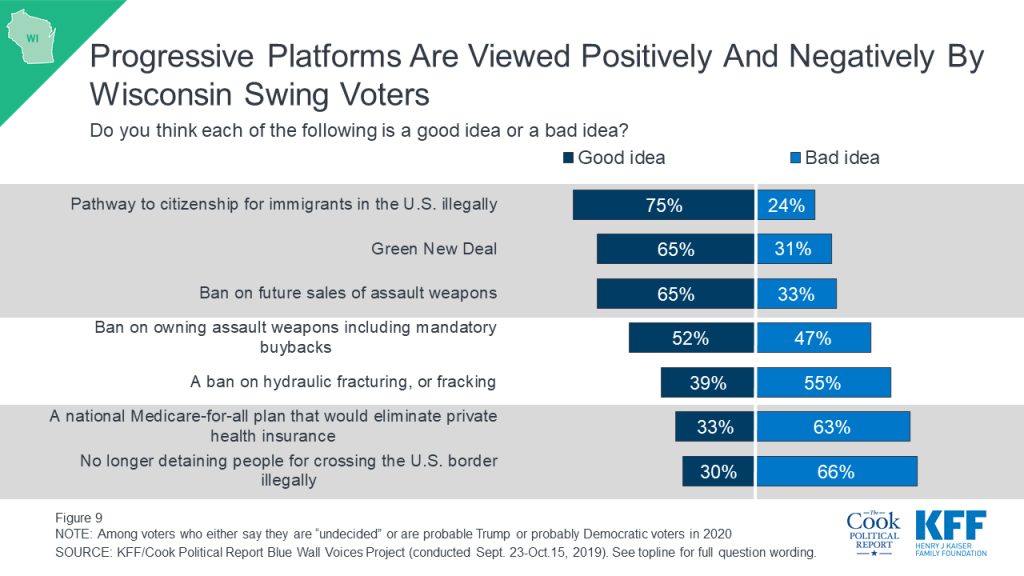
Methodology
The Blue Wall Voices Project was designed and analyzed by public opinion researchers at the Kaiser Family Foundation (KFF) in collaboration with the Cook Political Report. The survey was conducted September 23rd – October 15th, 2019, among a representative random sample of 3,222 registered voters in four states (767 in Michigan, 958 in Minnesota, 752 in Pennsylvania, and 745 in Wisconsin) constituting the “Democratic Blue Wall” – the area in the Upper Midwest that were previously considered Democratic strongholds, and where state polls performed poorly in 2016 and underestimated support for President Trump. All registered voters included in the sample were sent an invitation letter including a link to complete the survey online, a toll-free number that respondents could call to complete the survey with a telephone interviewer, and $2 pre-incentive. Respondents who were living in Census block-groups identified as low-education and respondents identified as likely Hispanic were offered $10 post-incentive if they completed the survey. A random half of respondents received a QR code on their invitation letters. All respondents were then sent a reminder postcard, which included a QR code for all respondents. Respondents who were flagged in the voter file as both a) speaking Spanish and b) speaking either primarily or only their native language, received bilingual mailings, including text in both English and Spanish.
The sample was designed to reach respondents less likely to complete surveys online, by oversampling areas with a relatively low percentage of college graduates. Sample that could be matched to telephone numbers and that had not yet completed the survey online or by inbound computer-assisted telephone interview (CATI) were called by CATI interviewers to attempt to convert this sample to completed interviews. A total of 2,763 respondents completed the questionnaire online, 255 by calling in to complete, and 204 were completed as outbound CATI interviews. Data collection was carried out in English and Spanish by SSRS of Glen Mills, PA. The registered voter sample was provided by Aristotle. KFF paid for all costs associated with the survey.
A series of data quality checks were run on the final data, which resulted in 40 completes being removed from the data. Weighting involved multiple stages: First, each state sample was weighted to account for the sampling methodology including the oversampling of low-educational attainment areas and to the proportions of the voter file reachable or unreachable by outbound phone-call. Second, each state’s sample was weighted to match the voter file distribution of 2016 voter status, party identification, gender, race/ethnicity, home-ownership, Metropolitan status, state region, as well as the 2018 CPS Voter Supplement for age-by-gender, educational attainment and race. To address non-response among partisans not accounted for by demographics, the weight was adjusted so that the self-reported 2016 vote in each state matched the actual state outcome. The final weight combined each state’s weight and balanced the combined total sample to state distributions. All statistical tests of significance account for the effect of weighting.
The margin of sampling error including the design effect for the full sample is plus or minus 2 percentage points. Numbers of respondents and margins of sampling error for each state are shown in the table below. For results based on other subgroups, the margin of sampling error may be higher. Sample sizes and margins of sampling error for other subgroups are available by request. Note that sampling error is only one of many potential sources of error in this or any other public opinion poll. Kaiser Family Foundation public opinion and survey research is a charter member of the Transparency Initiative of the American Association for Public Opinion Research.
Endnotes
- In the wake of the 2016 election there was some speculation that voters who were planning to support President Trump were reluctant to express this to interviewers during public opinion polls. This “shy Trump voter” hypothesis was not found to be a meaningful contribution to the polling errors in 2016. By examining whether voters were less willing to express support for President Trump during a live interview compared to an online response, we found no evidence of any voters, regardless of party identification, being less willing to express support for President Trump during live interview surveys. It is also important to note that while we did not find evidence of shy Trump voters, this may be a result of respondents being able to self-select into their various modes. ↩︎
- The Blue Wall Voices Project began on September 23rd, 2019, one day before House Speaker Nancy Pelosi announced a formal impeachment inquiry into Trump on September 24th as a result of President Trump’s phone call with the Ukrainian President. As the field period continued into October, we did see an increase in the share of voters who mentioned President Trump’s commitment to constitution in their responses to this question. ↩︎